Risk Management in A-Four Printing Firm
VerifiedAdded on 2023/01/12
|31
|11682
|72
AI Summary
This document provides an overview of risk management in the context of A-Four Printing firm. It discusses the steps of risk management, the scope of the risk management process, stakeholder analysis, and the importance of evaluating strengths and weaknesses. It also explores the benefits of reviewing different policy contexts and the support needed for risk management activities. The document concludes with a discussion on the major concerns and risks, as well as the challenges and attributes of risk management.
Contribute Materials
Your contribution can guide someone’s learning journey. Share your
documents today.
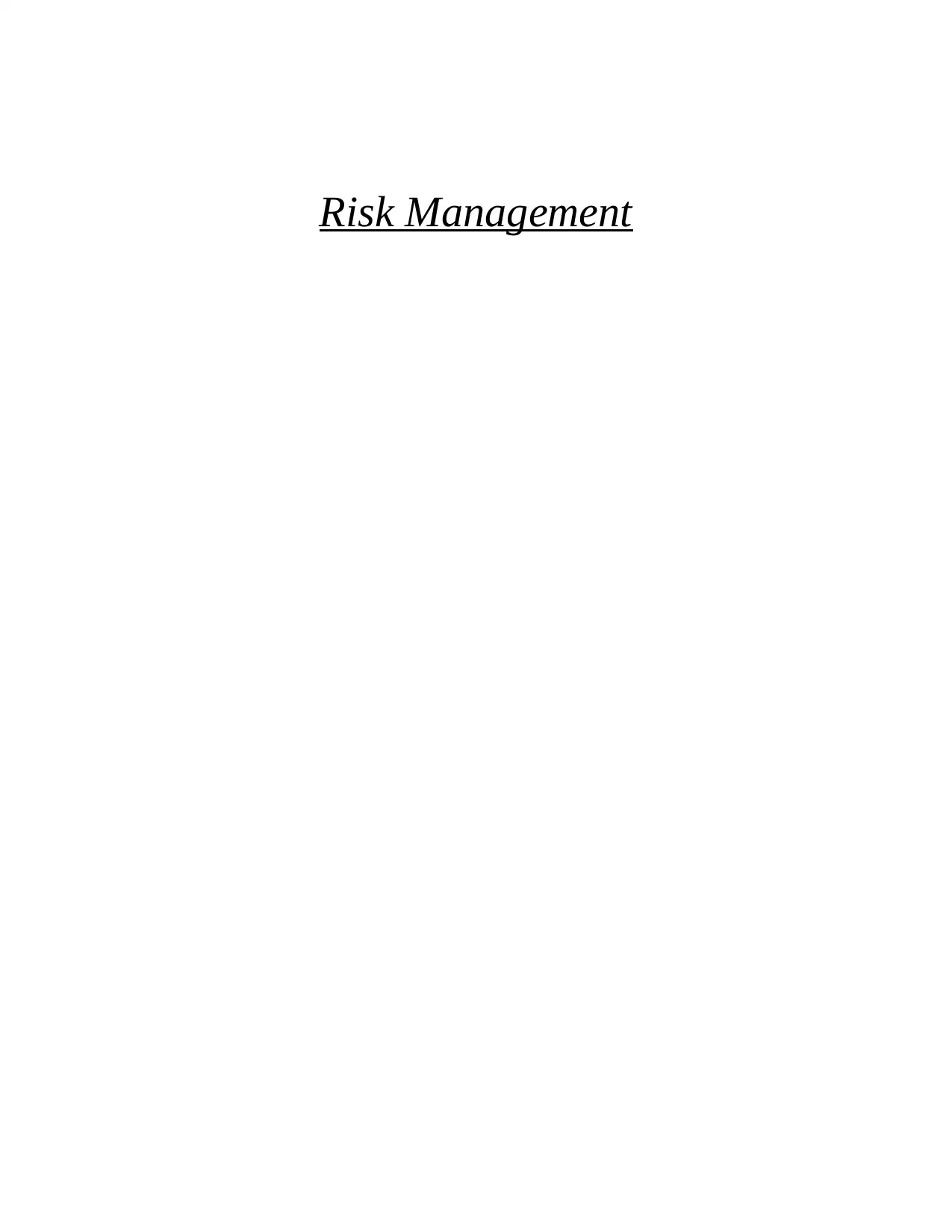
Risk Management
Secure Best Marks with AI Grader
Need help grading? Try our AI Grader for instant feedback on your assignments.
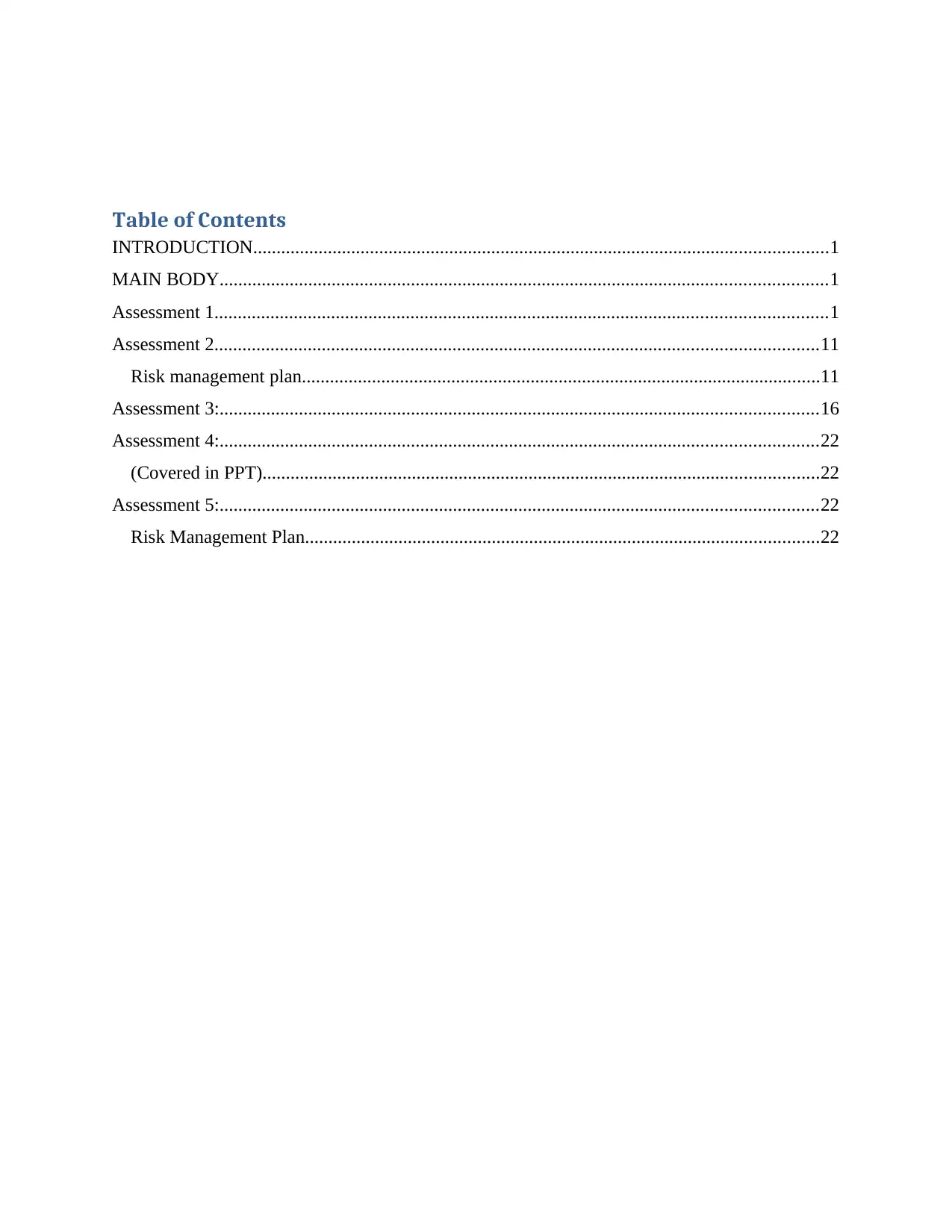
Table of Contents
INTRODUCTION...........................................................................................................................1
MAIN BODY..................................................................................................................................1
Assessment 1...................................................................................................................................1
Assessment 2.................................................................................................................................11
Risk management plan...............................................................................................................11
Assessment 3:................................................................................................................................16
Assessment 4:................................................................................................................................22
(Covered in PPT).......................................................................................................................22
Assessment 5:................................................................................................................................22
Risk Management Plan..............................................................................................................22
INTRODUCTION...........................................................................................................................1
MAIN BODY..................................................................................................................................1
Assessment 1...................................................................................................................................1
Assessment 2.................................................................................................................................11
Risk management plan...............................................................................................................11
Assessment 3:................................................................................................................................16
Assessment 4:................................................................................................................................22
(Covered in PPT).......................................................................................................................22
Assessment 5:................................................................................................................................22
Risk Management Plan..............................................................................................................22

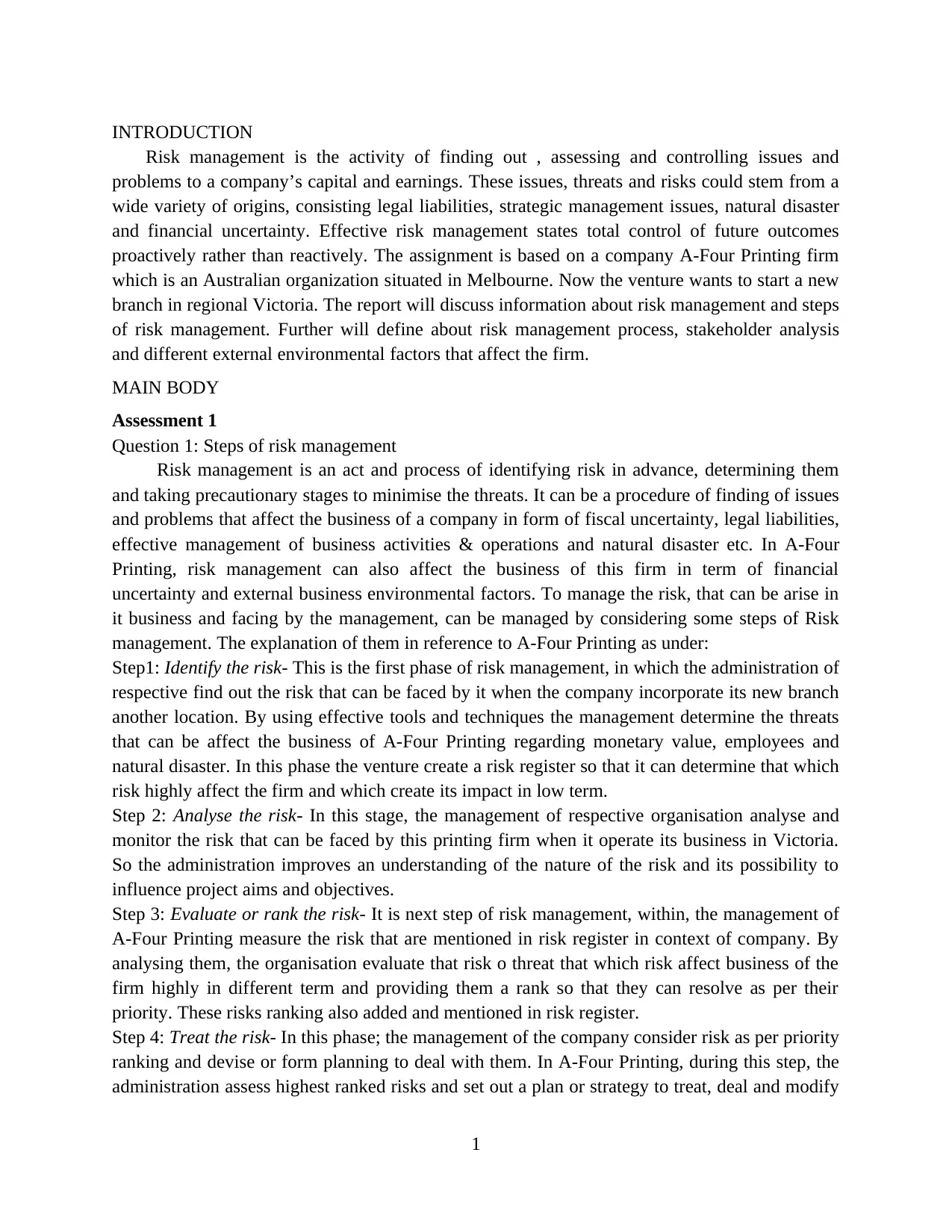
INTRODUCTION
Risk management is the activity of finding out , assessing and controlling issues and
problems to a company’s capital and earnings. These issues, threats and risks could stem from a
wide variety of origins, consisting legal liabilities, strategic management issues, natural disaster
and financial uncertainty. Effective risk management states total control of future outcomes
proactively rather than reactively. The assignment is based on a company A-Four Printing firm
which is an Australian organization situated in Melbourne. Now the venture wants to start a new
branch in regional Victoria. The report will discuss information about risk management and steps
of risk management. Further will define about risk management process, stakeholder analysis
and different external environmental factors that affect the firm.
MAIN BODY
Assessment 1
Question 1: Steps of risk management
Risk management is an act and process of identifying risk in advance, determining them
and taking precautionary stages to minimise the threats. It can be a procedure of finding of issues
and problems that affect the business of a company in form of fiscal uncertainty, legal liabilities,
effective management of business activities & operations and natural disaster etc. In A-Four
Printing, risk management can also affect the business of this firm in term of financial
uncertainty and external business environmental factors. To manage the risk, that can be arise in
it business and facing by the management, can be managed by considering some steps of Risk
management. The explanation of them in reference to A-Four Printing as under:
Step1: Identify the risk- This is the first phase of risk management, in which the administration of
respective find out the risk that can be faced by it when the company incorporate its new branch
another location. By using effective tools and techniques the management determine the threats
that can be affect the business of A-Four Printing regarding monetary value, employees and
natural disaster. In this phase the venture create a risk register so that it can determine that which
risk highly affect the firm and which create its impact in low term.
Step 2: Analyse the risk- In this stage, the management of respective organisation analyse and
monitor the risk that can be faced by this printing firm when it operate its business in Victoria.
So the administration improves an understanding of the nature of the risk and its possibility to
influence project aims and objectives.
Step 3: Evaluate or rank the risk- It is next step of risk management, within, the management of
A-Four Printing measure the risk that are mentioned in risk register in context of company. By
analysing them, the organisation evaluate that risk o threat that which risk affect business of the
firm highly in different term and providing them a rank so that they can resolve as per their
priority. These risks ranking also added and mentioned in risk register.
Step 4: Treat the risk- In this phase; the management of the company consider risk as per priority
ranking and devise or form planning to deal with them. In A-Four Printing, during this step, the
administration assess highest ranked risks and set out a plan or strategy to treat, deal and modify
1
Risk management is the activity of finding out , assessing and controlling issues and
problems to a company’s capital and earnings. These issues, threats and risks could stem from a
wide variety of origins, consisting legal liabilities, strategic management issues, natural disaster
and financial uncertainty. Effective risk management states total control of future outcomes
proactively rather than reactively. The assignment is based on a company A-Four Printing firm
which is an Australian organization situated in Melbourne. Now the venture wants to start a new
branch in regional Victoria. The report will discuss information about risk management and steps
of risk management. Further will define about risk management process, stakeholder analysis
and different external environmental factors that affect the firm.
MAIN BODY
Assessment 1
Question 1: Steps of risk management
Risk management is an act and process of identifying risk in advance, determining them
and taking precautionary stages to minimise the threats. It can be a procedure of finding of issues
and problems that affect the business of a company in form of fiscal uncertainty, legal liabilities,
effective management of business activities & operations and natural disaster etc. In A-Four
Printing, risk management can also affect the business of this firm in term of financial
uncertainty and external business environmental factors. To manage the risk, that can be arise in
it business and facing by the management, can be managed by considering some steps of Risk
management. The explanation of them in reference to A-Four Printing as under:
Step1: Identify the risk- This is the first phase of risk management, in which the administration of
respective find out the risk that can be faced by it when the company incorporate its new branch
another location. By using effective tools and techniques the management determine the threats
that can be affect the business of A-Four Printing regarding monetary value, employees and
natural disaster. In this phase the venture create a risk register so that it can determine that which
risk highly affect the firm and which create its impact in low term.
Step 2: Analyse the risk- In this stage, the management of respective organisation analyse and
monitor the risk that can be faced by this printing firm when it operate its business in Victoria.
So the administration improves an understanding of the nature of the risk and its possibility to
influence project aims and objectives.
Step 3: Evaluate or rank the risk- It is next step of risk management, within, the management of
A-Four Printing measure the risk that are mentioned in risk register in context of company. By
analysing them, the organisation evaluate that risk o threat that which risk affect business of the
firm highly in different term and providing them a rank so that they can resolve as per their
priority. These risks ranking also added and mentioned in risk register.
Step 4: Treat the risk- In this phase; the management of the company consider risk as per priority
ranking and devise or form planning to deal with them. In A-Four Printing, during this step, the
administration assess highest ranked risks and set out a plan or strategy to treat, deal and modify
1
Secure Best Marks with AI Grader
Need help grading? Try our AI Grader for instant feedback on your assignments.
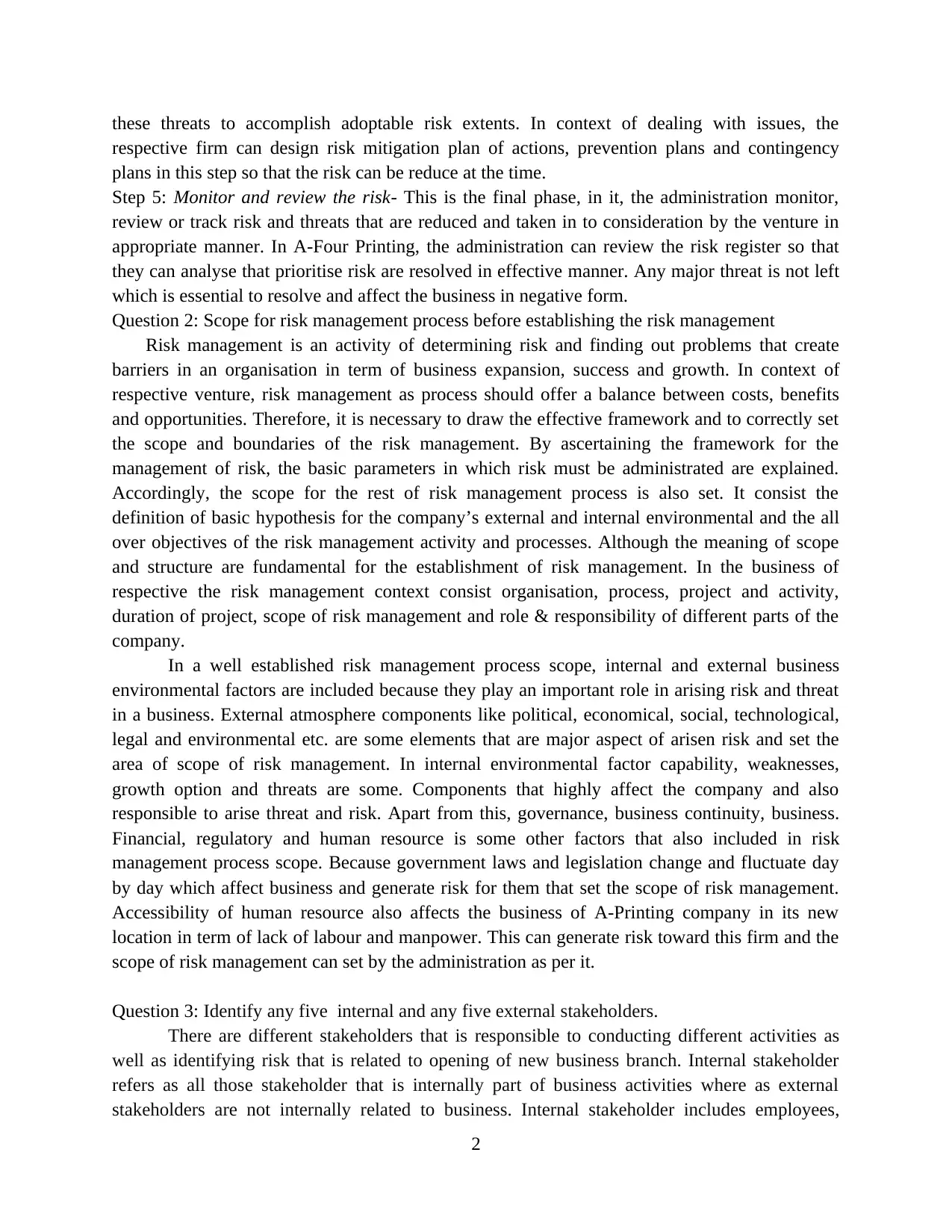
these threats to accomplish adoptable risk extents. In context of dealing with issues, the
respective firm can design risk mitigation plan of actions, prevention plans and contingency
plans in this step so that the risk can be reduce at the time.
Step 5: Monitor and review the risk- This is the final phase, in it, the administration monitor,
review or track risk and threats that are reduced and taken in to consideration by the venture in
appropriate manner. In A-Four Printing, the administration can review the risk register so that
they can analyse that prioritise risk are resolved in effective manner. Any major threat is not left
which is essential to resolve and affect the business in negative form.
Question 2: Scope for risk management process before establishing the risk management
Risk management is an activity of determining risk and finding out problems that create
barriers in an organisation in term of business expansion, success and growth. In context of
respective venture, risk management as process should offer a balance between costs, benefits
and opportunities. Therefore, it is necessary to draw the effective framework and to correctly set
the scope and boundaries of the risk management. By ascertaining the framework for the
management of risk, the basic parameters in which risk must be administrated are explained.
Accordingly, the scope for the rest of risk management process is also set. It consist the
definition of basic hypothesis for the company’s external and internal environmental and the all
over objectives of the risk management activity and processes. Although the meaning of scope
and structure are fundamental for the establishment of risk management. In the business of
respective the risk management context consist organisation, process, project and activity,
duration of project, scope of risk management and role & responsibility of different parts of the
company.
In a well established risk management process scope, internal and external business
environmental factors are included because they play an important role in arising risk and threat
in a business. External atmosphere components like political, economical, social, technological,
legal and environmental etc. are some elements that are major aspect of arisen risk and set the
area of scope of risk management. In internal environmental factor capability, weaknesses,
growth option and threats are some. Components that highly affect the company and also
responsible to arise threat and risk. Apart from this, governance, business continuity, business.
Financial, regulatory and human resource is some other factors that also included in risk
management process scope. Because government laws and legislation change and fluctuate day
by day which affect business and generate risk for them that set the scope of risk management.
Accessibility of human resource also affects the business of A-Printing company in its new
location in term of lack of labour and manpower. This can generate risk toward this firm and the
scope of risk management can set by the administration as per it.
Question 3: Identify any five internal and any five external stakeholders.
There are different stakeholders that is responsible to conducting different activities as
well as identifying risk that is related to opening of new business branch. Internal stakeholder
refers as all those stakeholder that is internally part of business activities where as external
stakeholders are not internally related to business. Internal stakeholder includes employees,
2
respective firm can design risk mitigation plan of actions, prevention plans and contingency
plans in this step so that the risk can be reduce at the time.
Step 5: Monitor and review the risk- This is the final phase, in it, the administration monitor,
review or track risk and threats that are reduced and taken in to consideration by the venture in
appropriate manner. In A-Four Printing, the administration can review the risk register so that
they can analyse that prioritise risk are resolved in effective manner. Any major threat is not left
which is essential to resolve and affect the business in negative form.
Question 2: Scope for risk management process before establishing the risk management
Risk management is an activity of determining risk and finding out problems that create
barriers in an organisation in term of business expansion, success and growth. In context of
respective venture, risk management as process should offer a balance between costs, benefits
and opportunities. Therefore, it is necessary to draw the effective framework and to correctly set
the scope and boundaries of the risk management. By ascertaining the framework for the
management of risk, the basic parameters in which risk must be administrated are explained.
Accordingly, the scope for the rest of risk management process is also set. It consist the
definition of basic hypothesis for the company’s external and internal environmental and the all
over objectives of the risk management activity and processes. Although the meaning of scope
and structure are fundamental for the establishment of risk management. In the business of
respective the risk management context consist organisation, process, project and activity,
duration of project, scope of risk management and role & responsibility of different parts of the
company.
In a well established risk management process scope, internal and external business
environmental factors are included because they play an important role in arising risk and threat
in a business. External atmosphere components like political, economical, social, technological,
legal and environmental etc. are some elements that are major aspect of arisen risk and set the
area of scope of risk management. In internal environmental factor capability, weaknesses,
growth option and threats are some. Components that highly affect the company and also
responsible to arise threat and risk. Apart from this, governance, business continuity, business.
Financial, regulatory and human resource is some other factors that also included in risk
management process scope. Because government laws and legislation change and fluctuate day
by day which affect business and generate risk for them that set the scope of risk management.
Accessibility of human resource also affects the business of A-Printing company in its new
location in term of lack of labour and manpower. This can generate risk toward this firm and the
scope of risk management can set by the administration as per it.
Question 3: Identify any five internal and any five external stakeholders.
There are different stakeholders that is responsible to conducting different activities as
well as identifying risk that is related to opening of new business branch. Internal stakeholder
refers as all those stakeholder that is internally part of business activities where as external
stakeholders are not internally related to business. Internal stakeholder includes employees,
2
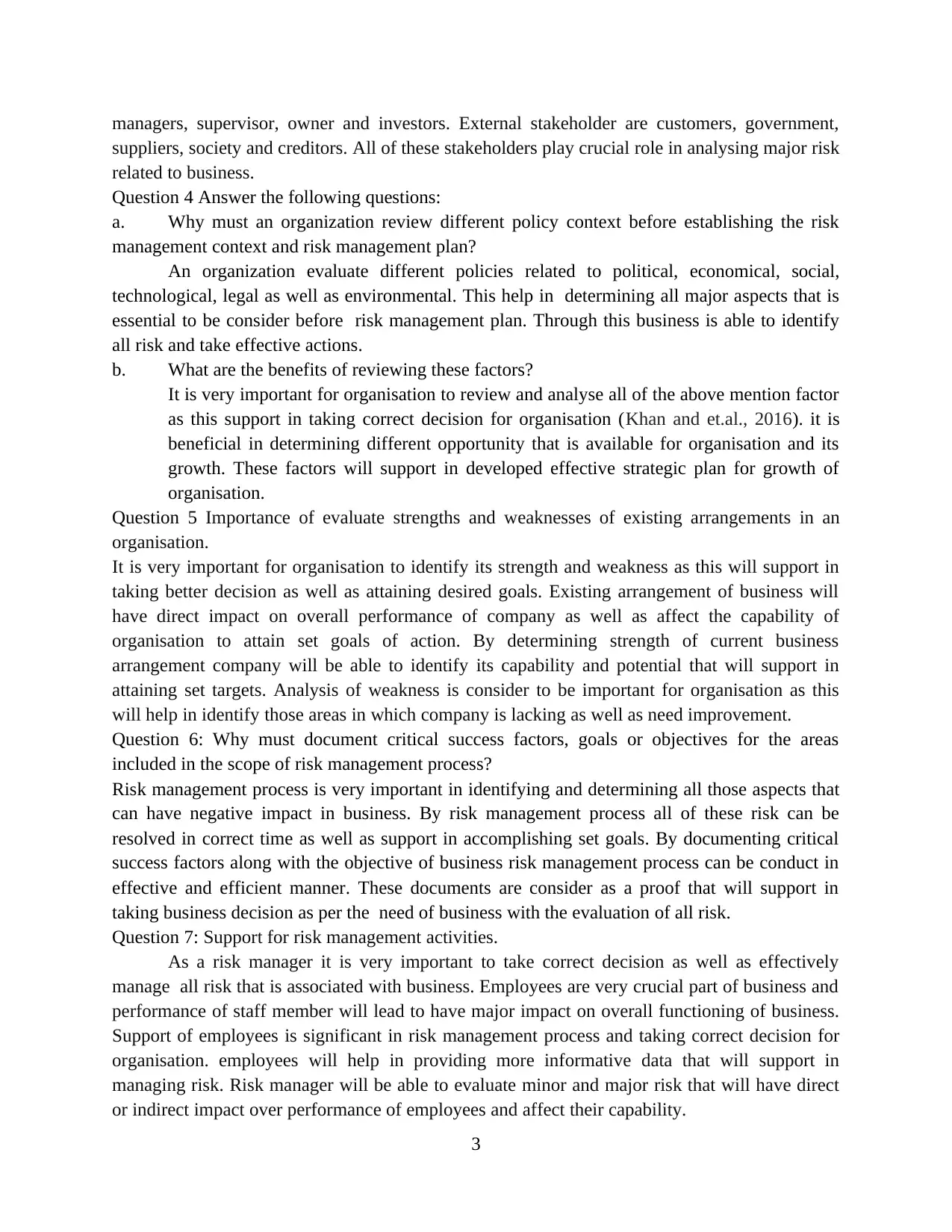
managers, supervisor, owner and investors. External stakeholder are customers, government,
suppliers, society and creditors. All of these stakeholders play crucial role in analysing major risk
related to business.
Question 4 Answer the following questions:
a. Why must an organization review different policy context before establishing the risk
management context and risk management plan?
An organization evaluate different policies related to political, economical, social,
technological, legal as well as environmental. This help in determining all major aspects that is
essential to be consider before risk management plan. Through this business is able to identify
all risk and take effective actions.
b. What are the benefits of reviewing these factors?
It is very important for organisation to review and analyse all of the above mention factor
as this support in taking correct decision for organisation (Khan and et.al., 2016). it is
beneficial in determining different opportunity that is available for organisation and its
growth. These factors will support in developed effective strategic plan for growth of
organisation.
Question 5 Importance of evaluate strengths and weaknesses of existing arrangements in an
organisation.
It is very important for organisation to identify its strength and weakness as this will support in
taking better decision as well as attaining desired goals. Existing arrangement of business will
have direct impact on overall performance of company as well as affect the capability of
organisation to attain set goals of action. By determining strength of current business
arrangement company will be able to identify its capability and potential that will support in
attaining set targets. Analysis of weakness is consider to be important for organisation as this
will help in identify those areas in which company is lacking as well as need improvement.
Question 6: Why must document critical success factors, goals or objectives for the areas
included in the scope of risk management process?
Risk management process is very important in identifying and determining all those aspects that
can have negative impact in business. By risk management process all of these risk can be
resolved in correct time as well as support in accomplishing set goals. By documenting critical
success factors along with the objective of business risk management process can be conduct in
effective and efficient manner. These documents are consider as a proof that will support in
taking business decision as per the need of business with the evaluation of all risk.
Question 7: Support for risk management activities.
As a risk manager it is very important to take correct decision as well as effectively
manage all risk that is associated with business. Employees are very crucial part of business and
performance of staff member will lead to have major impact on overall functioning of business.
Support of employees is significant in risk management process and taking correct decision for
organisation. employees will help in providing more informative data that will support in
managing risk. Risk manager will be able to evaluate minor and major risk that will have direct
or indirect impact over performance of employees and affect their capability.
3
suppliers, society and creditors. All of these stakeholders play crucial role in analysing major risk
related to business.
Question 4 Answer the following questions:
a. Why must an organization review different policy context before establishing the risk
management context and risk management plan?
An organization evaluate different policies related to political, economical, social,
technological, legal as well as environmental. This help in determining all major aspects that is
essential to be consider before risk management plan. Through this business is able to identify
all risk and take effective actions.
b. What are the benefits of reviewing these factors?
It is very important for organisation to review and analyse all of the above mention factor
as this support in taking correct decision for organisation (Khan and et.al., 2016). it is
beneficial in determining different opportunity that is available for organisation and its
growth. These factors will support in developed effective strategic plan for growth of
organisation.
Question 5 Importance of evaluate strengths and weaknesses of existing arrangements in an
organisation.
It is very important for organisation to identify its strength and weakness as this will support in
taking better decision as well as attaining desired goals. Existing arrangement of business will
have direct impact on overall performance of company as well as affect the capability of
organisation to attain set goals of action. By determining strength of current business
arrangement company will be able to identify its capability and potential that will support in
attaining set targets. Analysis of weakness is consider to be important for organisation as this
will help in identify those areas in which company is lacking as well as need improvement.
Question 6: Why must document critical success factors, goals or objectives for the areas
included in the scope of risk management process?
Risk management process is very important in identifying and determining all those aspects that
can have negative impact in business. By risk management process all of these risk can be
resolved in correct time as well as support in accomplishing set goals. By documenting critical
success factors along with the objective of business risk management process can be conduct in
effective and efficient manner. These documents are consider as a proof that will support in
taking business decision as per the need of business with the evaluation of all risk.
Question 7: Support for risk management activities.
As a risk manager it is very important to take correct decision as well as effectively
manage all risk that is associated with business. Employees are very crucial part of business and
performance of staff member will lead to have major impact on overall functioning of business.
Support of employees is significant in risk management process and taking correct decision for
organisation. employees will help in providing more informative data that will support in
managing risk. Risk manager will be able to evaluate minor and major risk that will have direct
or indirect impact over performance of employees and affect their capability.
3
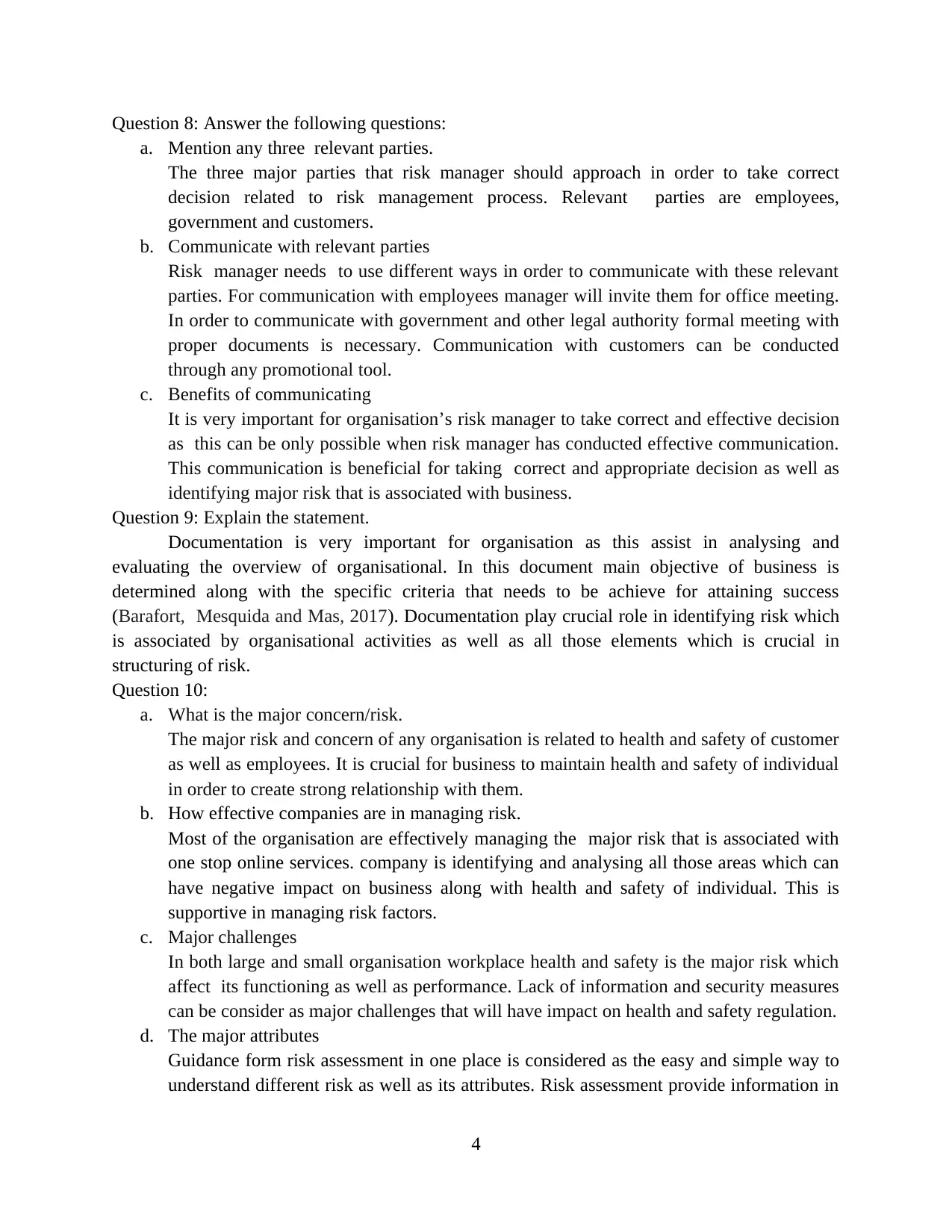
Question 8: Answer the following questions:
a. Mention any three relevant parties.
The three major parties that risk manager should approach in order to take correct
decision related to risk management process. Relevant parties are employees,
government and customers.
b. Communicate with relevant parties
Risk manager needs to use different ways in order to communicate with these relevant
parties. For communication with employees manager will invite them for office meeting.
In order to communicate with government and other legal authority formal meeting with
proper documents is necessary. Communication with customers can be conducted
through any promotional tool.
c. Benefits of communicating
It is very important for organisation’s risk manager to take correct and effective decision
as this can be only possible when risk manager has conducted effective communication.
This communication is beneficial for taking correct and appropriate decision as well as
identifying major risk that is associated with business.
Question 9: Explain the statement.
Documentation is very important for organisation as this assist in analysing and
evaluating the overview of organisational. In this document main objective of business is
determined along with the specific criteria that needs to be achieve for attaining success
(Barafort, Mesquida and Mas, 2017). Documentation play crucial role in identifying risk which
is associated by organisational activities as well as all those elements which is crucial in
structuring of risk.
Question 10:
a. What is the major concern/risk.
The major risk and concern of any organisation is related to health and safety of customer
as well as employees. It is crucial for business to maintain health and safety of individual
in order to create strong relationship with them.
b. How effective companies are in managing risk.
Most of the organisation are effectively managing the major risk that is associated with
one stop online services. company is identifying and analysing all those areas which can
have negative impact on business along with health and safety of individual. This is
supportive in managing risk factors.
c. Major challenges
In both large and small organisation workplace health and safety is the major risk which
affect its functioning as well as performance. Lack of information and security measures
can be consider as major challenges that will have impact on health and safety regulation.
d. The major attributes
Guidance form risk assessment in one place is considered as the easy and simple way to
understand different risk as well as its attributes. Risk assessment provide information in
4
a. Mention any three relevant parties.
The three major parties that risk manager should approach in order to take correct
decision related to risk management process. Relevant parties are employees,
government and customers.
b. Communicate with relevant parties
Risk manager needs to use different ways in order to communicate with these relevant
parties. For communication with employees manager will invite them for office meeting.
In order to communicate with government and other legal authority formal meeting with
proper documents is necessary. Communication with customers can be conducted
through any promotional tool.
c. Benefits of communicating
It is very important for organisation’s risk manager to take correct and effective decision
as this can be only possible when risk manager has conducted effective communication.
This communication is beneficial for taking correct and appropriate decision as well as
identifying major risk that is associated with business.
Question 9: Explain the statement.
Documentation is very important for organisation as this assist in analysing and
evaluating the overview of organisational. In this document main objective of business is
determined along with the specific criteria that needs to be achieve for attaining success
(Barafort, Mesquida and Mas, 2017). Documentation play crucial role in identifying risk which
is associated by organisational activities as well as all those elements which is crucial in
structuring of risk.
Question 10:
a. What is the major concern/risk.
The major risk and concern of any organisation is related to health and safety of customer
as well as employees. It is crucial for business to maintain health and safety of individual
in order to create strong relationship with them.
b. How effective companies are in managing risk.
Most of the organisation are effectively managing the major risk that is associated with
one stop online services. company is identifying and analysing all those areas which can
have negative impact on business along with health and safety of individual. This is
supportive in managing risk factors.
c. Major challenges
In both large and small organisation workplace health and safety is the major risk which
affect its functioning as well as performance. Lack of information and security measures
can be consider as major challenges that will have impact on health and safety regulation.
d. The major attributes
Guidance form risk assessment in one place is considered as the easy and simple way to
understand different risk as well as its attributes. Risk assessment provide information in
4
Paraphrase This Document
Need a fresh take? Get an instant paraphrase of this document with our AI Paraphraser
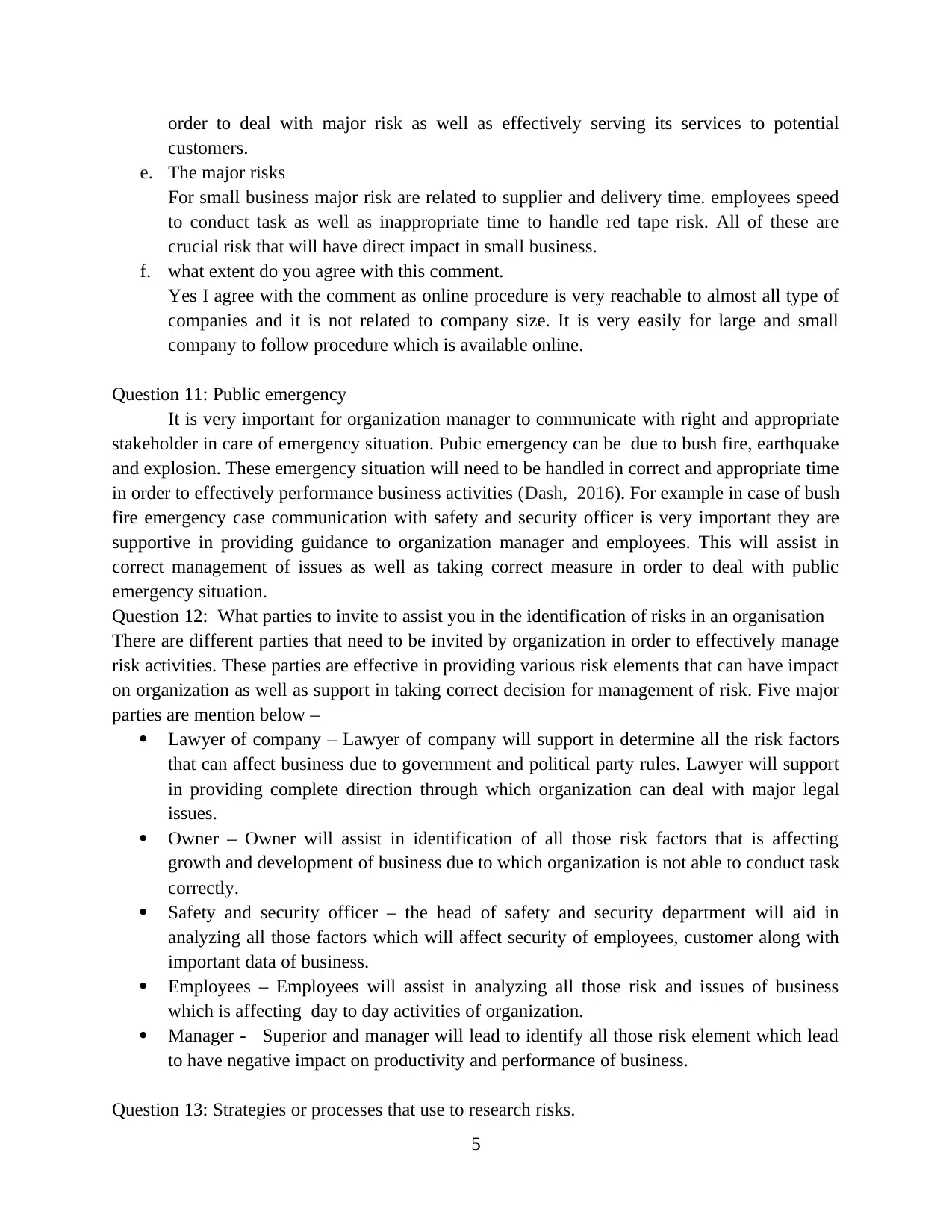
order to deal with major risk as well as effectively serving its services to potential
customers.
e. The major risks
For small business major risk are related to supplier and delivery time. employees speed
to conduct task as well as inappropriate time to handle red tape risk. All of these are
crucial risk that will have direct impact in small business.
f. what extent do you agree with this comment.
Yes I agree with the comment as online procedure is very reachable to almost all type of
companies and it is not related to company size. It is very easily for large and small
company to follow procedure which is available online.
Question 11: Public emergency
It is very important for organization manager to communicate with right and appropriate
stakeholder in care of emergency situation. Pubic emergency can be due to bush fire, earthquake
and explosion. These emergency situation will need to be handled in correct and appropriate time
in order to effectively performance business activities (Dash, 2016). For example in case of bush
fire emergency case communication with safety and security officer is very important they are
supportive in providing guidance to organization manager and employees. This will assist in
correct management of issues as well as taking correct measure in order to deal with public
emergency situation.
Question 12: What parties to invite to assist you in the identification of risks in an organisation
There are different parties that need to be invited by organization in order to effectively manage
risk activities. These parties are effective in providing various risk elements that can have impact
on organization as well as support in taking correct decision for management of risk. Five major
parties are mention below –
Lawyer of company – Lawyer of company will support in determine all the risk factors
that can affect business due to government and political party rules. Lawyer will support
in providing complete direction through which organization can deal with major legal
issues.
Owner – Owner will assist in identification of all those risk factors that is affecting
growth and development of business due to which organization is not able to conduct task
correctly.
Safety and security officer – the head of safety and security department will aid in
analyzing all those factors which will affect security of employees, customer along with
important data of business.
Employees – Employees will assist in analyzing all those risk and issues of business
which is affecting day to day activities of organization.
Manager - Superior and manager will lead to identify all those risk element which lead
to have negative impact on productivity and performance of business.
Question 13: Strategies or processes that use to research risks.
5
customers.
e. The major risks
For small business major risk are related to supplier and delivery time. employees speed
to conduct task as well as inappropriate time to handle red tape risk. All of these are
crucial risk that will have direct impact in small business.
f. what extent do you agree with this comment.
Yes I agree with the comment as online procedure is very reachable to almost all type of
companies and it is not related to company size. It is very easily for large and small
company to follow procedure which is available online.
Question 11: Public emergency
It is very important for organization manager to communicate with right and appropriate
stakeholder in care of emergency situation. Pubic emergency can be due to bush fire, earthquake
and explosion. These emergency situation will need to be handled in correct and appropriate time
in order to effectively performance business activities (Dash, 2016). For example in case of bush
fire emergency case communication with safety and security officer is very important they are
supportive in providing guidance to organization manager and employees. This will assist in
correct management of issues as well as taking correct measure in order to deal with public
emergency situation.
Question 12: What parties to invite to assist you in the identification of risks in an organisation
There are different parties that need to be invited by organization in order to effectively manage
risk activities. These parties are effective in providing various risk elements that can have impact
on organization as well as support in taking correct decision for management of risk. Five major
parties are mention below –
Lawyer of company – Lawyer of company will support in determine all the risk factors
that can affect business due to government and political party rules. Lawyer will support
in providing complete direction through which organization can deal with major legal
issues.
Owner – Owner will assist in identification of all those risk factors that is affecting
growth and development of business due to which organization is not able to conduct task
correctly.
Safety and security officer – the head of safety and security department will aid in
analyzing all those factors which will affect security of employees, customer along with
important data of business.
Employees – Employees will assist in analyzing all those risk and issues of business
which is affecting day to day activities of organization.
Manager - Superior and manager will lead to identify all those risk element which lead
to have negative impact on productivity and performance of business.
Question 13: Strategies or processes that use to research risks.
5
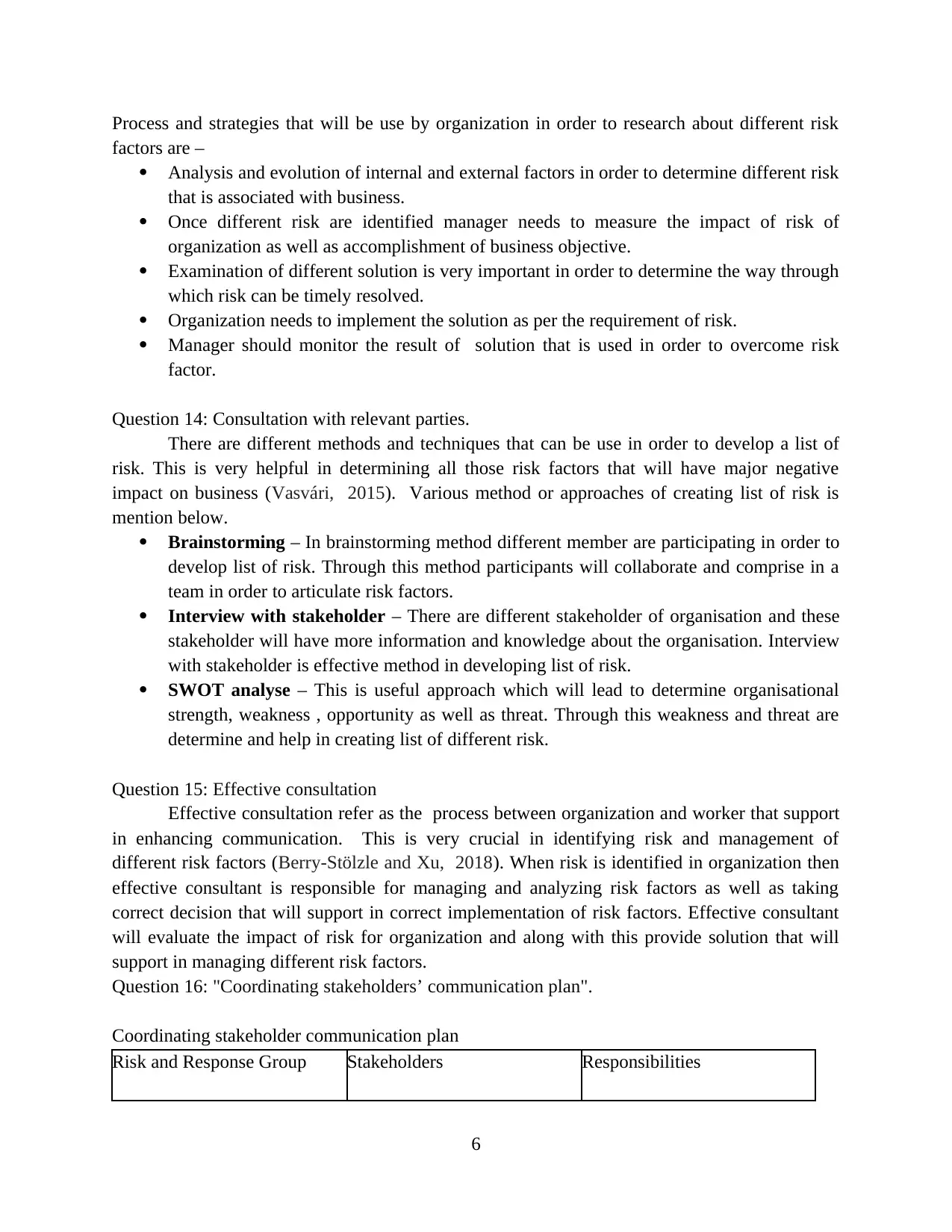
Process and strategies that will be use by organization in order to research about different risk
factors are –
Analysis and evolution of internal and external factors in order to determine different risk
that is associated with business.
Once different risk are identified manager needs to measure the impact of risk of
organization as well as accomplishment of business objective.
Examination of different solution is very important in order to determine the way through
which risk can be timely resolved.
Organization needs to implement the solution as per the requirement of risk.
Manager should monitor the result of solution that is used in order to overcome risk
factor.
Question 14: Consultation with relevant parties.
There are different methods and techniques that can be use in order to develop a list of
risk. This is very helpful in determining all those risk factors that will have major negative
impact on business (Vasvári, 2015). Various method or approaches of creating list of risk is
mention below.
Brainstorming – In brainstorming method different member are participating in order to
develop list of risk. Through this method participants will collaborate and comprise in a
team in order to articulate risk factors.
Interview with stakeholder – There are different stakeholder of organisation and these
stakeholder will have more information and knowledge about the organisation. Interview
with stakeholder is effective method in developing list of risk.
SWOT analyse – This is useful approach which will lead to determine organisational
strength, weakness , opportunity as well as threat. Through this weakness and threat are
determine and help in creating list of different risk.
Question 15: Effective consultation
Effective consultation refer as the process between organization and worker that support
in enhancing communication. This is very crucial in identifying risk and management of
different risk factors (Berry‐Stölzle and Xu, 2018). When risk is identified in organization then
effective consultant is responsible for managing and analyzing risk factors as well as taking
correct decision that will support in correct implementation of risk factors. Effective consultant
will evaluate the impact of risk for organization and along with this provide solution that will
support in managing different risk factors.
Question 16: "Coordinating stakeholders’ communication plan".
Coordinating stakeholder communication plan
Risk and Response Group Stakeholders Responsibilities
6
factors are –
Analysis and evolution of internal and external factors in order to determine different risk
that is associated with business.
Once different risk are identified manager needs to measure the impact of risk of
organization as well as accomplishment of business objective.
Examination of different solution is very important in order to determine the way through
which risk can be timely resolved.
Organization needs to implement the solution as per the requirement of risk.
Manager should monitor the result of solution that is used in order to overcome risk
factor.
Question 14: Consultation with relevant parties.
There are different methods and techniques that can be use in order to develop a list of
risk. This is very helpful in determining all those risk factors that will have major negative
impact on business (Vasvári, 2015). Various method or approaches of creating list of risk is
mention below.
Brainstorming – In brainstorming method different member are participating in order to
develop list of risk. Through this method participants will collaborate and comprise in a
team in order to articulate risk factors.
Interview with stakeholder – There are different stakeholder of organisation and these
stakeholder will have more information and knowledge about the organisation. Interview
with stakeholder is effective method in developing list of risk.
SWOT analyse – This is useful approach which will lead to determine organisational
strength, weakness , opportunity as well as threat. Through this weakness and threat are
determine and help in creating list of different risk.
Question 15: Effective consultation
Effective consultation refer as the process between organization and worker that support
in enhancing communication. This is very crucial in identifying risk and management of
different risk factors (Berry‐Stölzle and Xu, 2018). When risk is identified in organization then
effective consultant is responsible for managing and analyzing risk factors as well as taking
correct decision that will support in correct implementation of risk factors. Effective consultant
will evaluate the impact of risk for organization and along with this provide solution that will
support in managing different risk factors.
Question 16: "Coordinating stakeholders’ communication plan".
Coordinating stakeholder communication plan
Risk and Response Group Stakeholders Responsibilities
6
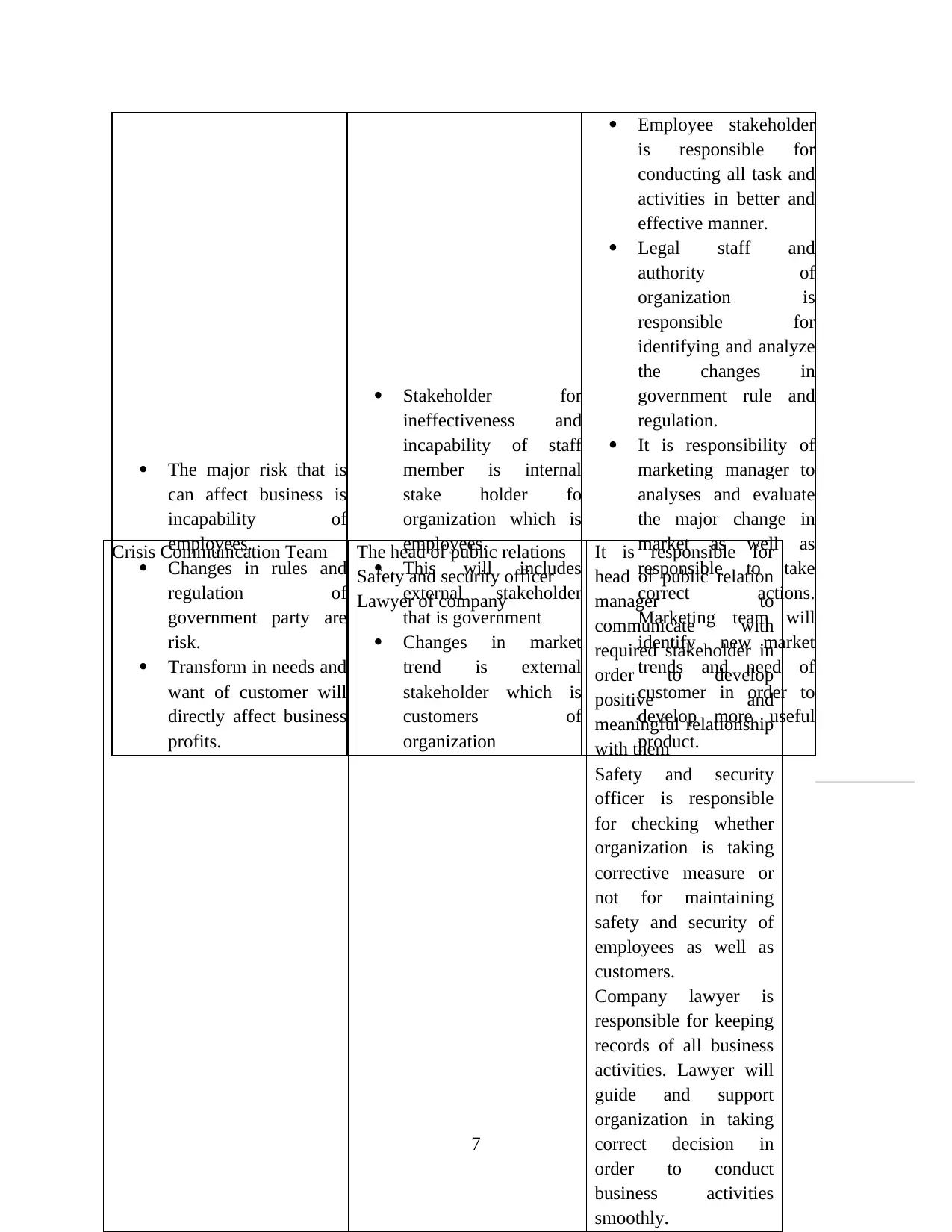
The major risk that is
can affect business is
incapability of
employees.
Changes in rules and
regulation of
government party are
risk.
Transform in needs and
want of customer will
directly affect business
profits.
Stakeholder for
ineffectiveness and
incapability of staff
member is internal
stake holder fo
organization which is
employees.
This will includes
external stakeholder
that is government
Changes in market
trend is external
stakeholder which is
customers of
organization
Employee stakeholder
is responsible for
conducting all task and
activities in better and
effective manner.
Legal staff and
authority of
organization is
responsible for
identifying and analyze
the changes in
government rule and
regulation.
It is responsibility of
marketing manager to
analyses and evaluate
the major change in
market as well as
responsible to take
correct actions.
Marketing team will
identify new market
trends and need of
customer in order to
develop more useful
product.
7
Crisis Communication Team The head of public relations
Safety and security officer
Lawyer of company
It is responsible for
head of public relation
manager to
communicate with
required stakeholder in
order to develop
positive and
meaningful relationship
with them
Safety and security
officer is responsible
for checking whether
organization is taking
corrective measure or
not for maintaining
safety and security of
employees as well as
customers.
Company lawyer is
responsible for keeping
records of all business
activities. Lawyer will
guide and support
organization in taking
correct decision in
order to conduct
business activities
smoothly.
can affect business is
incapability of
employees.
Changes in rules and
regulation of
government party are
risk.
Transform in needs and
want of customer will
directly affect business
profits.
Stakeholder for
ineffectiveness and
incapability of staff
member is internal
stake holder fo
organization which is
employees.
This will includes
external stakeholder
that is government
Changes in market
trend is external
stakeholder which is
customers of
organization
Employee stakeholder
is responsible for
conducting all task and
activities in better and
effective manner.
Legal staff and
authority of
organization is
responsible for
identifying and analyze
the changes in
government rule and
regulation.
It is responsibility of
marketing manager to
analyses and evaluate
the major change in
market as well as
responsible to take
correct actions.
Marketing team will
identify new market
trends and need of
customer in order to
develop more useful
product.
7
Crisis Communication Team The head of public relations
Safety and security officer
Lawyer of company
It is responsible for
head of public relation
manager to
communicate with
required stakeholder in
order to develop
positive and
meaningful relationship
with them
Safety and security
officer is responsible
for checking whether
organization is taking
corrective measure or
not for maintaining
safety and security of
employees as well as
customers.
Company lawyer is
responsible for keeping
records of all business
activities. Lawyer will
guide and support
organization in taking
correct decision in
order to conduct
business activities
smoothly.
Secure Best Marks with AI Grader
Need help grading? Try our AI Grader for instant feedback on your assignments.
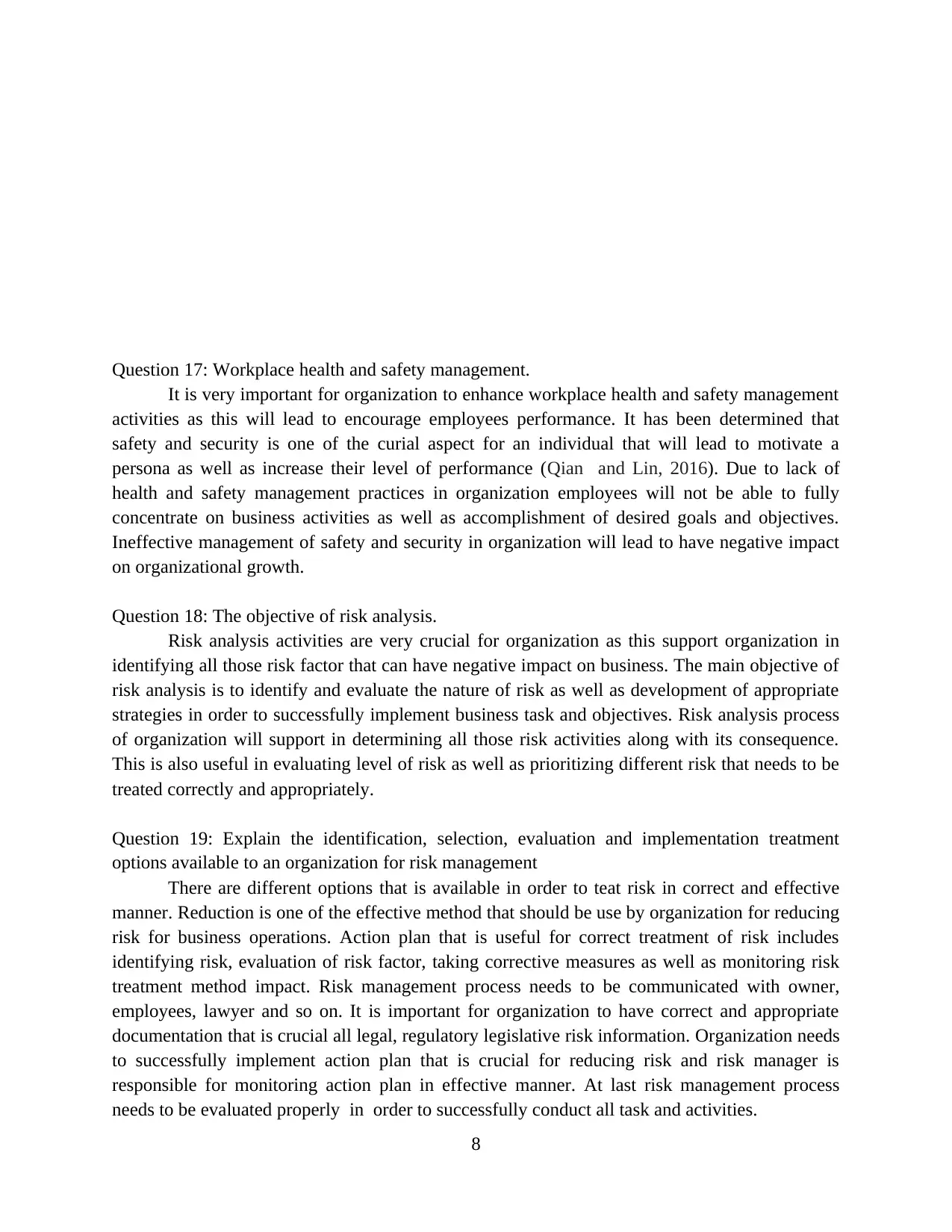
Question 17: Workplace health and safety management.
It is very important for organization to enhance workplace health and safety management
activities as this will lead to encourage employees performance. It has been determined that
safety and security is one of the curial aspect for an individual that will lead to motivate a
persona as well as increase their level of performance (Qian and Lin, 2016). Due to lack of
health and safety management practices in organization employees will not be able to fully
concentrate on business activities as well as accomplishment of desired goals and objectives.
Ineffective management of safety and security in organization will lead to have negative impact
on organizational growth.
Question 18: The objective of risk analysis.
Risk analysis activities are very crucial for organization as this support organization in
identifying all those risk factor that can have negative impact on business. The main objective of
risk analysis is to identify and evaluate the nature of risk as well as development of appropriate
strategies in order to successfully implement business task and objectives. Risk analysis process
of organization will support in determining all those risk activities along with its consequence.
This is also useful in evaluating level of risk as well as prioritizing different risk that needs to be
treated correctly and appropriately.
Question 19: Explain the identification, selection, evaluation and implementation treatment
options available to an organization for risk management
There are different options that is available in order to teat risk in correct and effective
manner. Reduction is one of the effective method that should be use by organization for reducing
risk for business operations. Action plan that is useful for correct treatment of risk includes
identifying risk, evaluation of risk factor, taking corrective measures as well as monitoring risk
treatment method impact. Risk management process needs to be communicated with owner,
employees, lawyer and so on. It is important for organization to have correct and appropriate
documentation that is crucial all legal, regulatory legislative risk information. Organization needs
to successfully implement action plan that is crucial for reducing risk and risk manager is
responsible for monitoring action plan in effective manner. At last risk management process
needs to be evaluated properly in order to successfully conduct all task and activities.
8
It is very important for organization to enhance workplace health and safety management
activities as this will lead to encourage employees performance. It has been determined that
safety and security is one of the curial aspect for an individual that will lead to motivate a
persona as well as increase their level of performance (Qian and Lin, 2016). Due to lack of
health and safety management practices in organization employees will not be able to fully
concentrate on business activities as well as accomplishment of desired goals and objectives.
Ineffective management of safety and security in organization will lead to have negative impact
on organizational growth.
Question 18: The objective of risk analysis.
Risk analysis activities are very crucial for organization as this support organization in
identifying all those risk factor that can have negative impact on business. The main objective of
risk analysis is to identify and evaluate the nature of risk as well as development of appropriate
strategies in order to successfully implement business task and objectives. Risk analysis process
of organization will support in determining all those risk activities along with its consequence.
This is also useful in evaluating level of risk as well as prioritizing different risk that needs to be
treated correctly and appropriately.
Question 19: Explain the identification, selection, evaluation and implementation treatment
options available to an organization for risk management
There are different options that is available in order to teat risk in correct and effective
manner. Reduction is one of the effective method that should be use by organization for reducing
risk for business operations. Action plan that is useful for correct treatment of risk includes
identifying risk, evaluation of risk factor, taking corrective measures as well as monitoring risk
treatment method impact. Risk management process needs to be communicated with owner,
employees, lawyer and so on. It is important for organization to have correct and appropriate
documentation that is crucial all legal, regulatory legislative risk information. Organization needs
to successfully implement action plan that is crucial for reducing risk and risk manager is
responsible for monitoring action plan in effective manner. At last risk management process
needs to be evaluated properly in order to successfully conduct all task and activities.
8
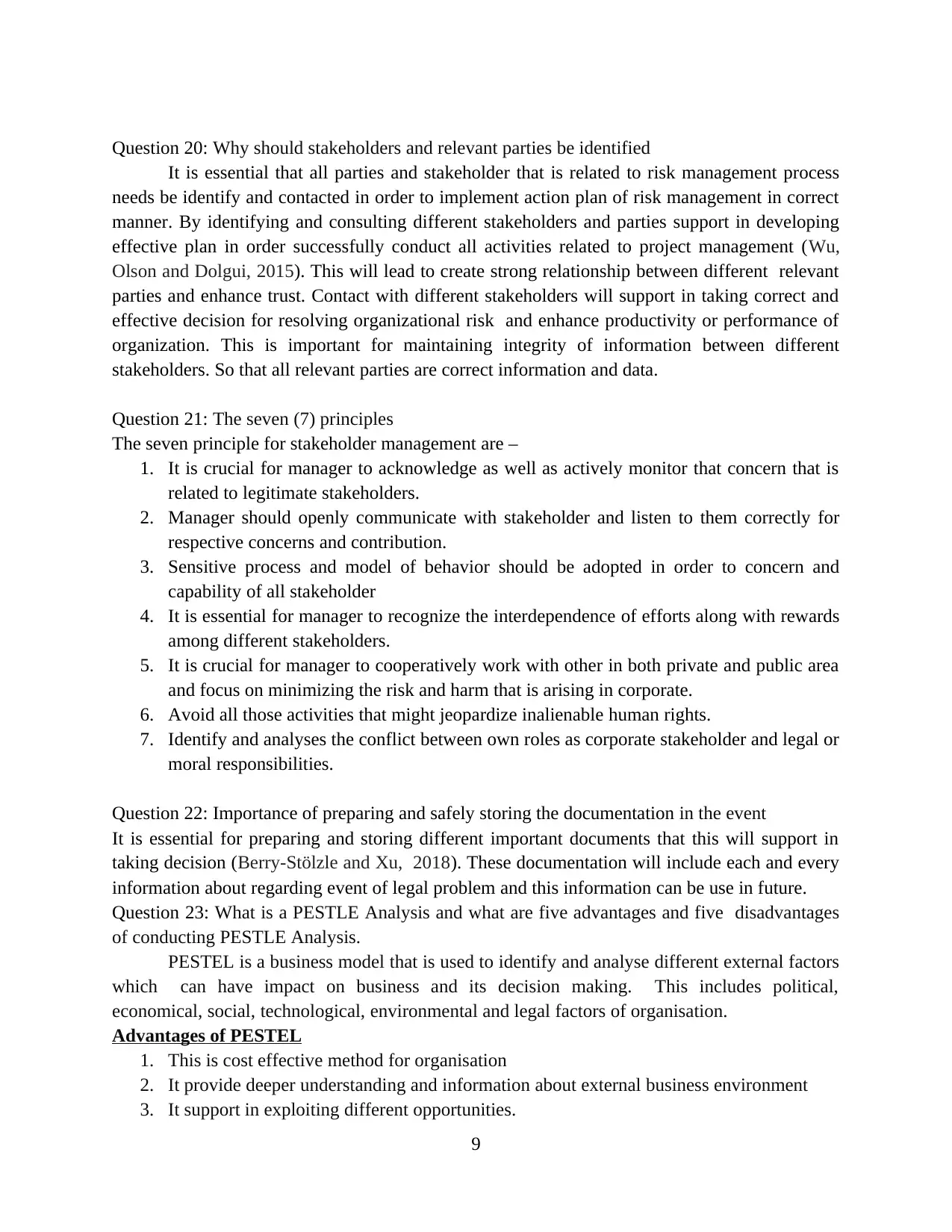
Question 20: Why should stakeholders and relevant parties be identified
It is essential that all parties and stakeholder that is related to risk management process
needs be identify and contacted in order to implement action plan of risk management in correct
manner. By identifying and consulting different stakeholders and parties support in developing
effective plan in order successfully conduct all activities related to project management (Wu,
Olson and Dolgui, 2015). This will lead to create strong relationship between different relevant
parties and enhance trust. Contact with different stakeholders will support in taking correct and
effective decision for resolving organizational risk and enhance productivity or performance of
organization. This is important for maintaining integrity of information between different
stakeholders. So that all relevant parties are correct information and data.
Question 21: The seven (7) principles
The seven principle for stakeholder management are –
1. It is crucial for manager to acknowledge as well as actively monitor that concern that is
related to legitimate stakeholders.
2. Manager should openly communicate with stakeholder and listen to them correctly for
respective concerns and contribution.
3. Sensitive process and model of behavior should be adopted in order to concern and
capability of all stakeholder
4. It is essential for manager to recognize the interdependence of efforts along with rewards
among different stakeholders.
5. It is crucial for manager to cooperatively work with other in both private and public area
and focus on minimizing the risk and harm that is arising in corporate.
6. Avoid all those activities that might jeopardize inalienable human rights.
7. Identify and analyses the conflict between own roles as corporate stakeholder and legal or
moral responsibilities.
Question 22: Importance of preparing and safely storing the documentation in the event
It is essential for preparing and storing different important documents that this will support in
taking decision (Berry‐Stölzle and Xu, 2018). These documentation will include each and every
information about regarding event of legal problem and this information can be use in future.
Question 23: What is a PESTLE Analysis and what are five advantages and five disadvantages
of conducting PESTLE Analysis.
PESTEL is a business model that is used to identify and analyse different external factors
which can have impact on business and its decision making. This includes political,
economical, social, technological, environmental and legal factors of organisation.
Advantages of PESTEL
1. This is cost effective method for organisation
2. It provide deeper understanding and information about external business environment
3. It support in exploiting different opportunities.
9
It is essential that all parties and stakeholder that is related to risk management process
needs be identify and contacted in order to implement action plan of risk management in correct
manner. By identifying and consulting different stakeholders and parties support in developing
effective plan in order successfully conduct all activities related to project management (Wu,
Olson and Dolgui, 2015). This will lead to create strong relationship between different relevant
parties and enhance trust. Contact with different stakeholders will support in taking correct and
effective decision for resolving organizational risk and enhance productivity or performance of
organization. This is important for maintaining integrity of information between different
stakeholders. So that all relevant parties are correct information and data.
Question 21: The seven (7) principles
The seven principle for stakeholder management are –
1. It is crucial for manager to acknowledge as well as actively monitor that concern that is
related to legitimate stakeholders.
2. Manager should openly communicate with stakeholder and listen to them correctly for
respective concerns and contribution.
3. Sensitive process and model of behavior should be adopted in order to concern and
capability of all stakeholder
4. It is essential for manager to recognize the interdependence of efforts along with rewards
among different stakeholders.
5. It is crucial for manager to cooperatively work with other in both private and public area
and focus on minimizing the risk and harm that is arising in corporate.
6. Avoid all those activities that might jeopardize inalienable human rights.
7. Identify and analyses the conflict between own roles as corporate stakeholder and legal or
moral responsibilities.
Question 22: Importance of preparing and safely storing the documentation in the event
It is essential for preparing and storing different important documents that this will support in
taking decision (Berry‐Stölzle and Xu, 2018). These documentation will include each and every
information about regarding event of legal problem and this information can be use in future.
Question 23: What is a PESTLE Analysis and what are five advantages and five disadvantages
of conducting PESTLE Analysis.
PESTEL is a business model that is used to identify and analyse different external factors
which can have impact on business and its decision making. This includes political,
economical, social, technological, environmental and legal factors of organisation.
Advantages of PESTEL
1. This is cost effective method for organisation
2. It provide deeper understanding and information about external business environment
3. It support in exploiting different opportunities.
9
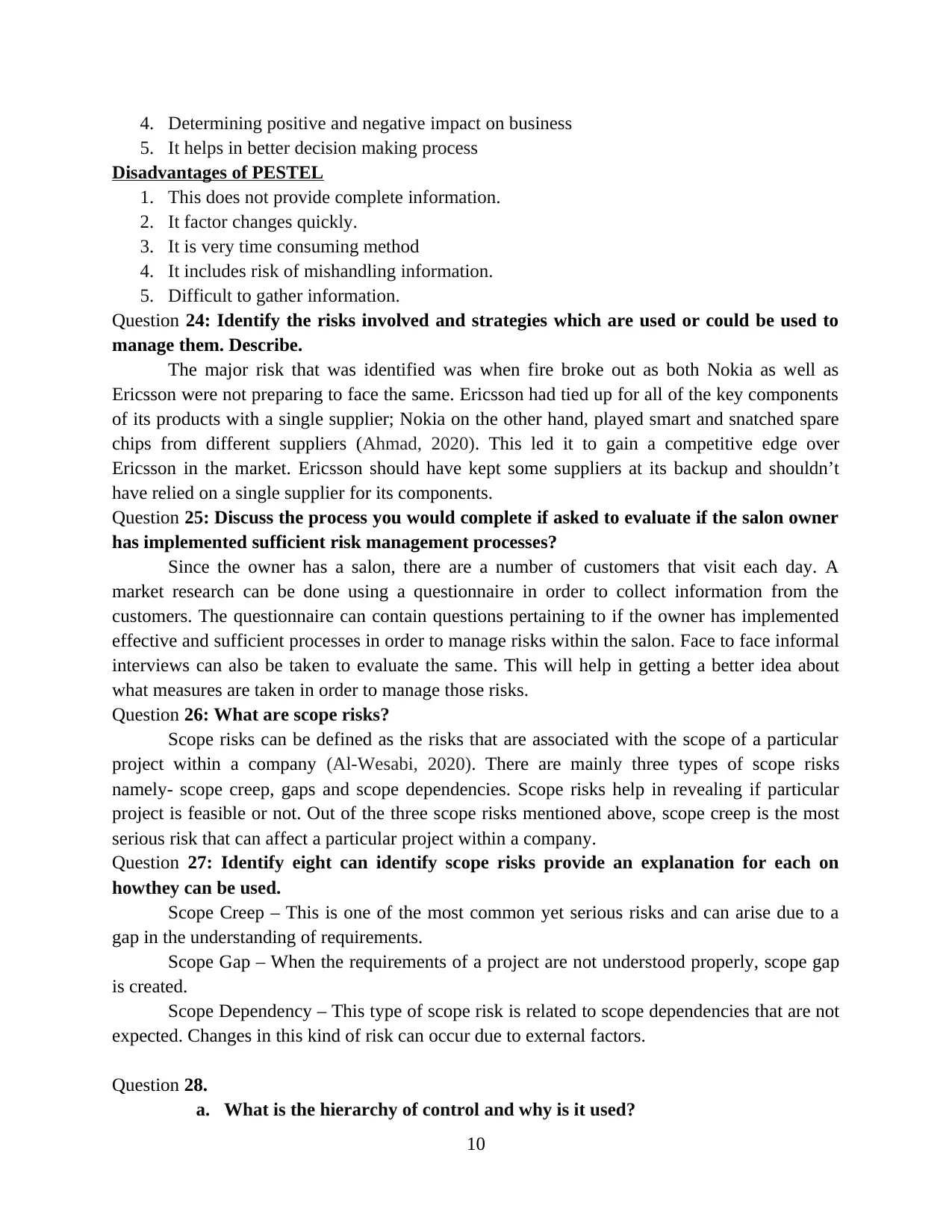
4. Determining positive and negative impact on business
5. It helps in better decision making process
Disadvantages of PESTEL
1. This does not provide complete information.
2. It factor changes quickly.
3. It is very time consuming method
4. It includes risk of mishandling information.
5. Difficult to gather information.
Question 24: Identify the risks involved and strategies which are used or could be used to
manage them. Describe.
The major risk that was identified was when fire broke out as both Nokia as well as
Ericsson were not preparing to face the same. Ericsson had tied up for all of the key components
of its products with a single supplier; Nokia on the other hand, played smart and snatched spare
chips from different suppliers (Ahmad, 2020). This led it to gain a competitive edge over
Ericsson in the market. Ericsson should have kept some suppliers at its backup and shouldn’t
have relied on a single supplier for its components.
Question 25: Discuss the process you would complete if asked to evaluate if the salon owner
has implemented sufficient risk management processes?
Since the owner has a salon, there are a number of customers that visit each day. A
market research can be done using a questionnaire in order to collect information from the
customers. The questionnaire can contain questions pertaining to if the owner has implemented
effective and sufficient processes in order to manage risks within the salon. Face to face informal
interviews can also be taken to evaluate the same. This will help in getting a better idea about
what measures are taken in order to manage those risks.
Question 26: What are scope risks?
Scope risks can be defined as the risks that are associated with the scope of a particular
project within a company (Al-Wesabi, 2020). There are mainly three types of scope risks
namely- scope creep, gaps and scope dependencies. Scope risks help in revealing if particular
project is feasible or not. Out of the three scope risks mentioned above, scope creep is the most
serious risk that can affect a particular project within a company.
Question 27: Identify eight can identify scope risks provide an explanation for each on
howthey can be used.
Scope Creep – This is one of the most common yet serious risks and can arise due to a
gap in the understanding of requirements.
Scope Gap – When the requirements of a project are not understood properly, scope gap
is created.
Scope Dependency – This type of scope risk is related to scope dependencies that are not
expected. Changes in this kind of risk can occur due to external factors.
Question 28.
a. What is the hierarchy of control and why is it used?
10
5. It helps in better decision making process
Disadvantages of PESTEL
1. This does not provide complete information.
2. It factor changes quickly.
3. It is very time consuming method
4. It includes risk of mishandling information.
5. Difficult to gather information.
Question 24: Identify the risks involved and strategies which are used or could be used to
manage them. Describe.
The major risk that was identified was when fire broke out as both Nokia as well as
Ericsson were not preparing to face the same. Ericsson had tied up for all of the key components
of its products with a single supplier; Nokia on the other hand, played smart and snatched spare
chips from different suppliers (Ahmad, 2020). This led it to gain a competitive edge over
Ericsson in the market. Ericsson should have kept some suppliers at its backup and shouldn’t
have relied on a single supplier for its components.
Question 25: Discuss the process you would complete if asked to evaluate if the salon owner
has implemented sufficient risk management processes?
Since the owner has a salon, there are a number of customers that visit each day. A
market research can be done using a questionnaire in order to collect information from the
customers. The questionnaire can contain questions pertaining to if the owner has implemented
effective and sufficient processes in order to manage risks within the salon. Face to face informal
interviews can also be taken to evaluate the same. This will help in getting a better idea about
what measures are taken in order to manage those risks.
Question 26: What are scope risks?
Scope risks can be defined as the risks that are associated with the scope of a particular
project within a company (Al-Wesabi, 2020). There are mainly three types of scope risks
namely- scope creep, gaps and scope dependencies. Scope risks help in revealing if particular
project is feasible or not. Out of the three scope risks mentioned above, scope creep is the most
serious risk that can affect a particular project within a company.
Question 27: Identify eight can identify scope risks provide an explanation for each on
howthey can be used.
Scope Creep – This is one of the most common yet serious risks and can arise due to a
gap in the understanding of requirements.
Scope Gap – When the requirements of a project are not understood properly, scope gap
is created.
Scope Dependency – This type of scope risk is related to scope dependencies that are not
expected. Changes in this kind of risk can occur due to external factors.
Question 28.
a. What is the hierarchy of control and why is it used?
10
Paraphrase This Document
Need a fresh take? Get an instant paraphrase of this document with our AI Paraphraser
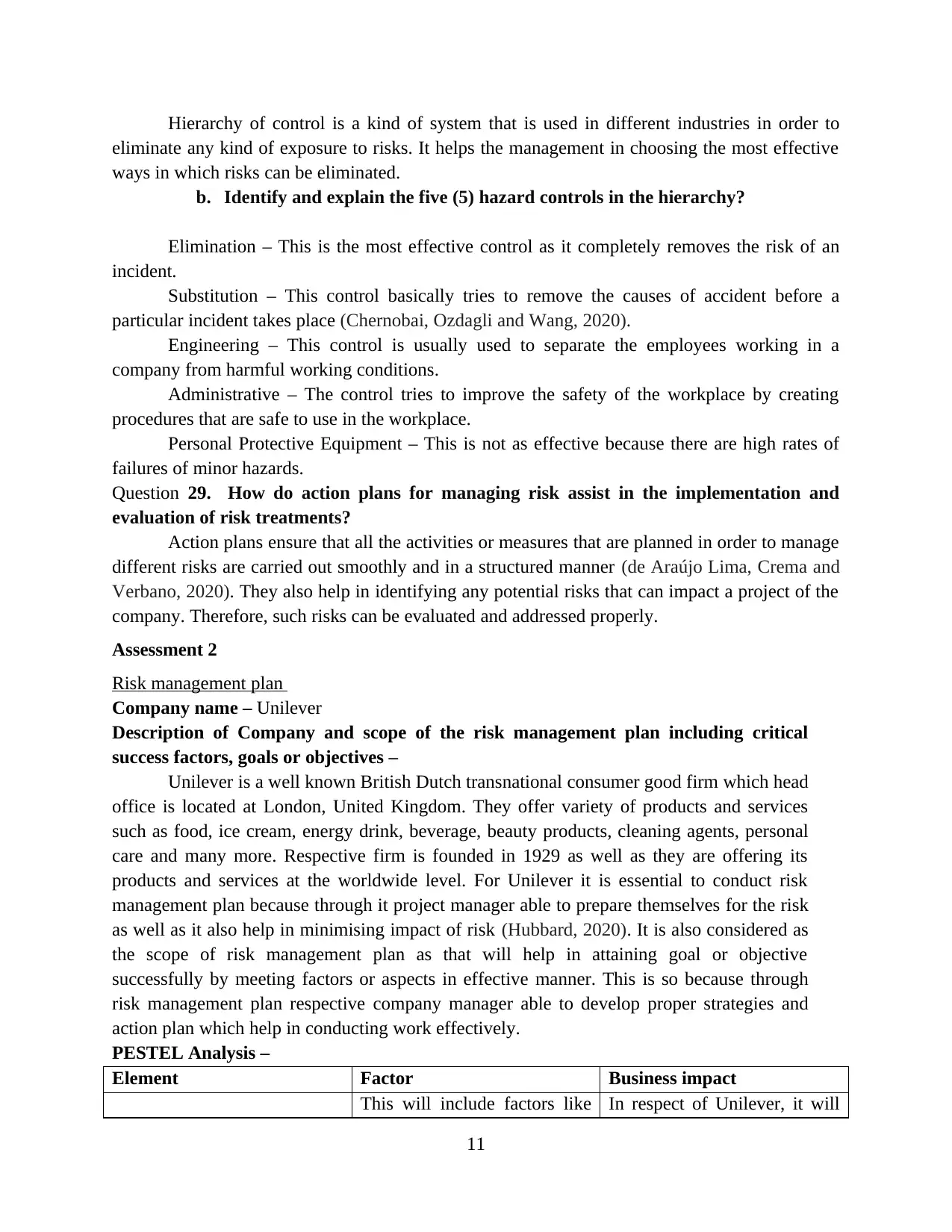
Hierarchy of control is a kind of system that is used in different industries in order to
eliminate any kind of exposure to risks. It helps the management in choosing the most effective
ways in which risks can be eliminated.
b. Identify and explain the five (5) hazard controls in the hierarchy?
Elimination – This is the most effective control as it completely removes the risk of an
incident.
Substitution – This control basically tries to remove the causes of accident before a
particular incident takes place (Chernobai, Ozdagli and Wang, 2020).
Engineering – This control is usually used to separate the employees working in a
company from harmful working conditions.
Administrative – The control tries to improve the safety of the workplace by creating
procedures that are safe to use in the workplace.
Personal Protective Equipment – This is not as effective because there are high rates of
failures of minor hazards.
Question 29. How do action plans for managing risk assist in the implementation and
evaluation of risk treatments?
Action plans ensure that all the activities or measures that are planned in order to manage
different risks are carried out smoothly and in a structured manner (de Araújo Lima, Crema and
Verbano, 2020). They also help in identifying any potential risks that can impact a project of the
company. Therefore, such risks can be evaluated and addressed properly.
Assessment 2
Risk management plan
Company name – Unilever
Description of Company and scope of the risk management plan including critical
success factors, goals or objectives –
Unilever is a well known British Dutch transnational consumer good firm which head
office is located at London, United Kingdom. They offer variety of products and services
such as food, ice cream, energy drink, beverage, beauty products, cleaning agents, personal
care and many more. Respective firm is founded in 1929 as well as they are offering its
products and services at the worldwide level. For Unilever it is essential to conduct risk
management plan because through it project manager able to prepare themselves for the risk
as well as it also help in minimising impact of risk (Hubbard, 2020). It is also considered as
the scope of risk management plan as that will help in attaining goal or objective
successfully by meeting factors or aspects in effective manner. This is so because through
risk management plan respective company manager able to develop proper strategies and
action plan which help in conducting work effectively.
PESTEL Analysis –
Element Factor Business impact
This will include factors like In respect of Unilever, it will
11
eliminate any kind of exposure to risks. It helps the management in choosing the most effective
ways in which risks can be eliminated.
b. Identify and explain the five (5) hazard controls in the hierarchy?
Elimination – This is the most effective control as it completely removes the risk of an
incident.
Substitution – This control basically tries to remove the causes of accident before a
particular incident takes place (Chernobai, Ozdagli and Wang, 2020).
Engineering – This control is usually used to separate the employees working in a
company from harmful working conditions.
Administrative – The control tries to improve the safety of the workplace by creating
procedures that are safe to use in the workplace.
Personal Protective Equipment – This is not as effective because there are high rates of
failures of minor hazards.
Question 29. How do action plans for managing risk assist in the implementation and
evaluation of risk treatments?
Action plans ensure that all the activities or measures that are planned in order to manage
different risks are carried out smoothly and in a structured manner (de Araújo Lima, Crema and
Verbano, 2020). They also help in identifying any potential risks that can impact a project of the
company. Therefore, such risks can be evaluated and addressed properly.
Assessment 2
Risk management plan
Company name – Unilever
Description of Company and scope of the risk management plan including critical
success factors, goals or objectives –
Unilever is a well known British Dutch transnational consumer good firm which head
office is located at London, United Kingdom. They offer variety of products and services
such as food, ice cream, energy drink, beverage, beauty products, cleaning agents, personal
care and many more. Respective firm is founded in 1929 as well as they are offering its
products and services at the worldwide level. For Unilever it is essential to conduct risk
management plan because through it project manager able to prepare themselves for the risk
as well as it also help in minimising impact of risk (Hubbard, 2020). It is also considered as
the scope of risk management plan as that will help in attaining goal or objective
successfully by meeting factors or aspects in effective manner. This is so because through
risk management plan respective company manager able to develop proper strategies and
action plan which help in conducting work effectively.
PESTEL Analysis –
Element Factor Business impact
This will include factors like In respect of Unilever, it will
11
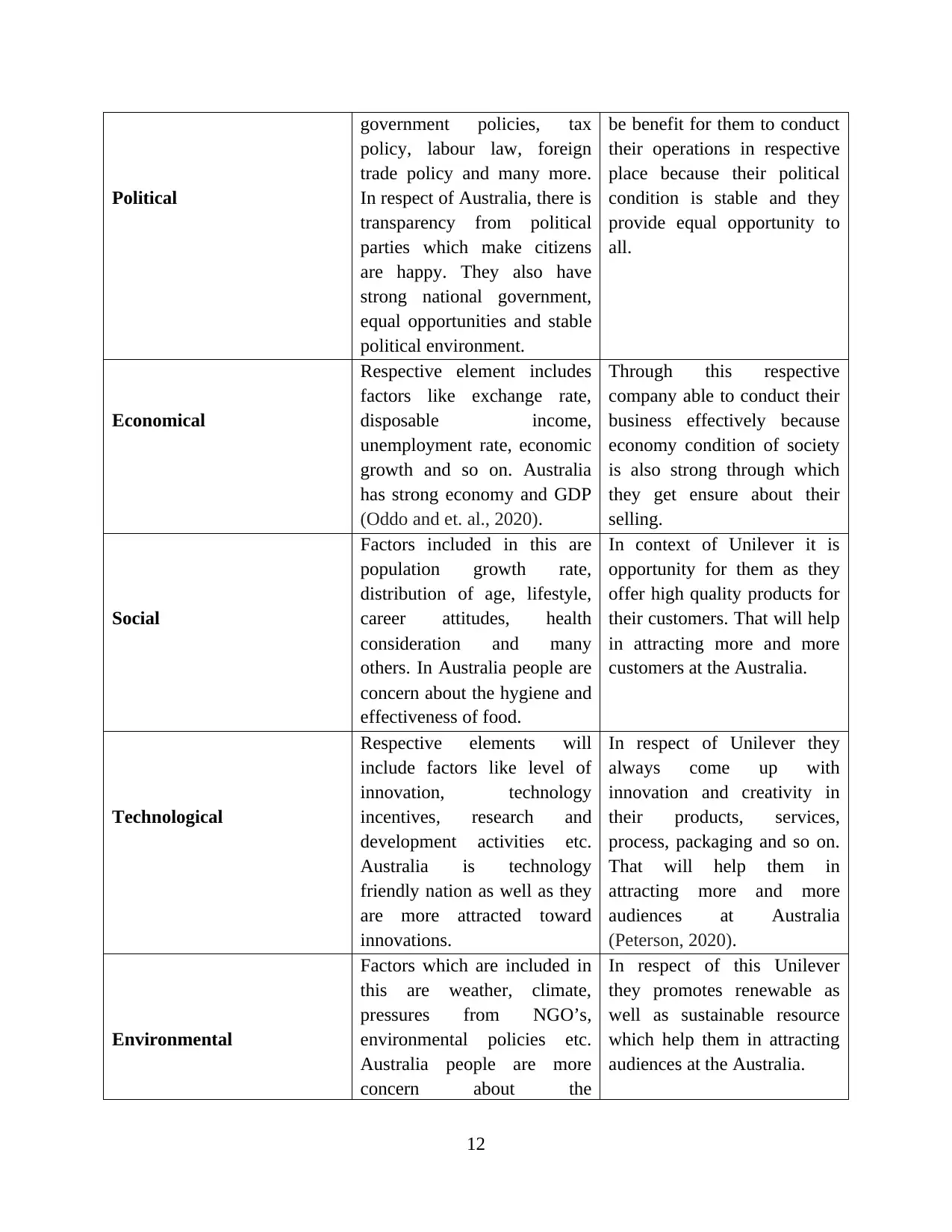
Political
government policies, tax
policy, labour law, foreign
trade policy and many more.
In respect of Australia, there is
transparency from political
parties which make citizens
are happy. They also have
strong national government,
equal opportunities and stable
political environment.
be benefit for them to conduct
their operations in respective
place because their political
condition is stable and they
provide equal opportunity to
all.
Economical
Respective element includes
factors like exchange rate,
disposable income,
unemployment rate, economic
growth and so on. Australia
has strong economy and GDP
(Oddo and et. al., 2020).
Through this respective
company able to conduct their
business effectively because
economy condition of society
is also strong through which
they get ensure about their
selling.
Social
Factors included in this are
population growth rate,
distribution of age, lifestyle,
career attitudes, health
consideration and many
others. In Australia people are
concern about the hygiene and
effectiveness of food.
In context of Unilever it is
opportunity for them as they
offer high quality products for
their customers. That will help
in attracting more and more
customers at the Australia.
Technological
Respective elements will
include factors like level of
innovation, technology
incentives, research and
development activities etc.
Australia is technology
friendly nation as well as they
are more attracted toward
innovations.
In respect of Unilever they
always come up with
innovation and creativity in
their products, services,
process, packaging and so on.
That will help them in
attracting more and more
audiences at Australia
(Peterson, 2020).
Environmental
Factors which are included in
this are weather, climate,
pressures from NGO’s,
environmental policies etc.
Australia people are more
concern about the
In respect of this Unilever
they promotes renewable as
well as sustainable resource
which help them in attracting
audiences at the Australia.
12
government policies, tax
policy, labour law, foreign
trade policy and many more.
In respect of Australia, there is
transparency from political
parties which make citizens
are happy. They also have
strong national government,
equal opportunities and stable
political environment.
be benefit for them to conduct
their operations in respective
place because their political
condition is stable and they
provide equal opportunity to
all.
Economical
Respective element includes
factors like exchange rate,
disposable income,
unemployment rate, economic
growth and so on. Australia
has strong economy and GDP
(Oddo and et. al., 2020).
Through this respective
company able to conduct their
business effectively because
economy condition of society
is also strong through which
they get ensure about their
selling.
Social
Factors included in this are
population growth rate,
distribution of age, lifestyle,
career attitudes, health
consideration and many
others. In Australia people are
concern about the hygiene and
effectiveness of food.
In context of Unilever it is
opportunity for them as they
offer high quality products for
their customers. That will help
in attracting more and more
customers at the Australia.
Technological
Respective elements will
include factors like level of
innovation, technology
incentives, research and
development activities etc.
Australia is technology
friendly nation as well as they
are more attracted toward
innovations.
In respect of Unilever they
always come up with
innovation and creativity in
their products, services,
process, packaging and so on.
That will help them in
attracting more and more
audiences at Australia
(Peterson, 2020).
Environmental
Factors which are included in
this are weather, climate,
pressures from NGO’s,
environmental policies etc.
Australia people are more
concern about the
In respect of this Unilever
they promotes renewable as
well as sustainable resource
which help them in attracting
audiences at the Australia.
12
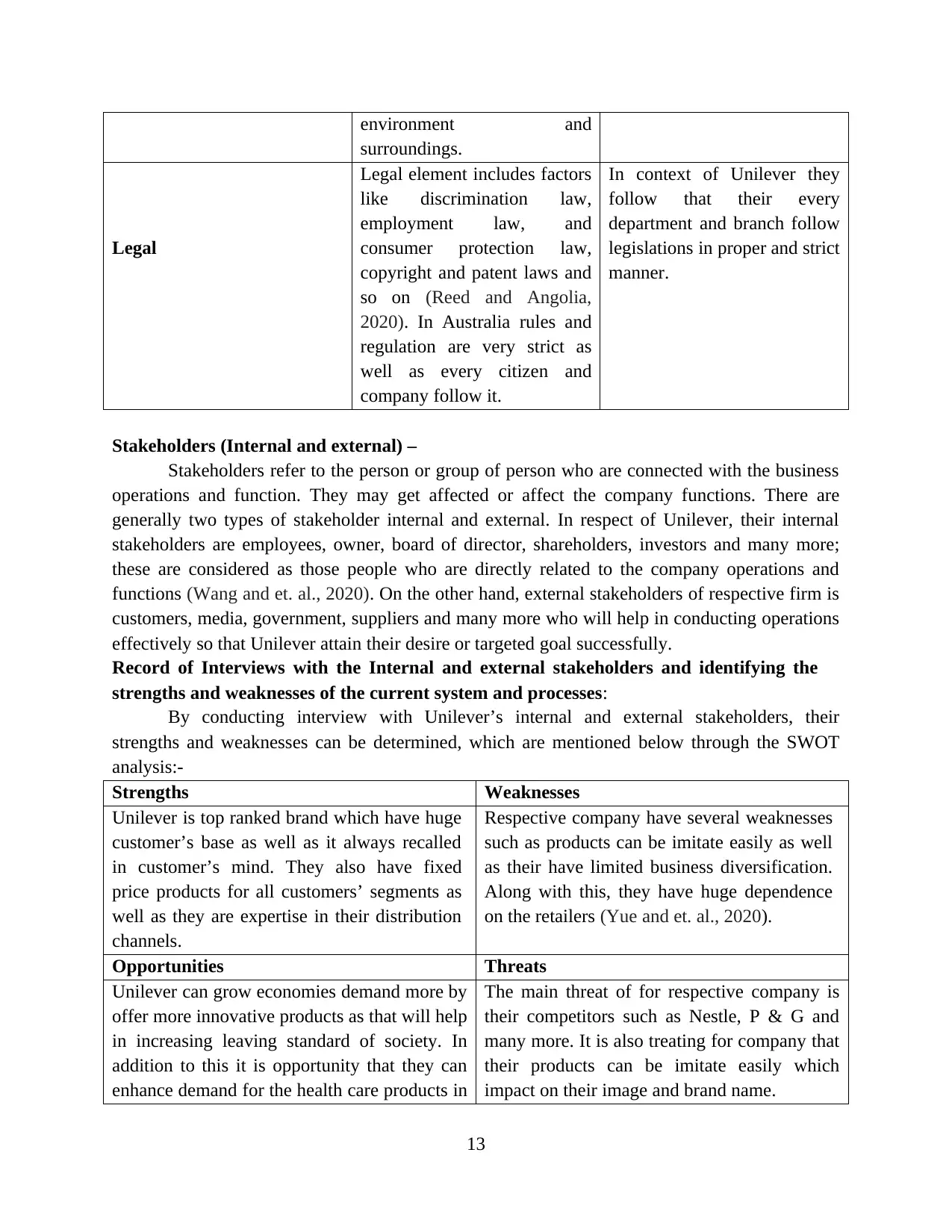
environment and
surroundings.
Legal
Legal element includes factors
like discrimination law,
employment law, and
consumer protection law,
copyright and patent laws and
so on (Reed and Angolia,
2020). In Australia rules and
regulation are very strict as
well as every citizen and
company follow it.
In context of Unilever they
follow that their every
department and branch follow
legislations in proper and strict
manner.
Stakeholders (Internal and external) –
Stakeholders refer to the person or group of person who are connected with the business
operations and function. They may get affected or affect the company functions. There are
generally two types of stakeholder internal and external. In respect of Unilever, their internal
stakeholders are employees, owner, board of director, shareholders, investors and many more;
these are considered as those people who are directly related to the company operations and
functions (Wang and et. al., 2020). On the other hand, external stakeholders of respective firm is
customers, media, government, suppliers and many more who will help in conducting operations
effectively so that Unilever attain their desire or targeted goal successfully.
Record of Interviews with the Internal and external stakeholders and identifying the
strengths and weaknesses of the current system and processes:
By conducting interview with Unilever’s internal and external stakeholders, their
strengths and weaknesses can be determined, which are mentioned below through the SWOT
analysis:-
Strengths Weaknesses
Unilever is top ranked brand which have huge
customer’s base as well as it always recalled
in customer’s mind. They also have fixed
price products for all customers’ segments as
well as they are expertise in their distribution
channels.
Respective company have several weaknesses
such as products can be imitate easily as well
as their have limited business diversification.
Along with this, they have huge dependence
on the retailers (Yue and et. al., 2020).
Opportunities Threats
Unilever can grow economies demand more by
offer more innovative products as that will help
in increasing leaving standard of society. In
addition to this it is opportunity that they can
enhance demand for the health care products in
The main threat of for respective company is
their competitors such as Nestle, P & G and
many more. It is also treating for company that
their products can be imitate easily which
impact on their image and brand name.
13
surroundings.
Legal
Legal element includes factors
like discrimination law,
employment law, and
consumer protection law,
copyright and patent laws and
so on (Reed and Angolia,
2020). In Australia rules and
regulation are very strict as
well as every citizen and
company follow it.
In context of Unilever they
follow that their every
department and branch follow
legislations in proper and strict
manner.
Stakeholders (Internal and external) –
Stakeholders refer to the person or group of person who are connected with the business
operations and function. They may get affected or affect the company functions. There are
generally two types of stakeholder internal and external. In respect of Unilever, their internal
stakeholders are employees, owner, board of director, shareholders, investors and many more;
these are considered as those people who are directly related to the company operations and
functions (Wang and et. al., 2020). On the other hand, external stakeholders of respective firm is
customers, media, government, suppliers and many more who will help in conducting operations
effectively so that Unilever attain their desire or targeted goal successfully.
Record of Interviews with the Internal and external stakeholders and identifying the
strengths and weaknesses of the current system and processes:
By conducting interview with Unilever’s internal and external stakeholders, their
strengths and weaknesses can be determined, which are mentioned below through the SWOT
analysis:-
Strengths Weaknesses
Unilever is top ranked brand which have huge
customer’s base as well as it always recalled
in customer’s mind. They also have fixed
price products for all customers’ segments as
well as they are expertise in their distribution
channels.
Respective company have several weaknesses
such as products can be imitate easily as well
as their have limited business diversification.
Along with this, they have huge dependence
on the retailers (Yue and et. al., 2020).
Opportunities Threats
Unilever can grow economies demand more by
offer more innovative products as that will help
in increasing leaving standard of society. In
addition to this it is opportunity that they can
enhance demand for the health care products in
The main threat of for respective company is
their competitors such as Nestle, P & G and
many more. It is also treating for company that
their products can be imitate easily which
impact on their image and brand name.
13
Secure Best Marks with AI Grader
Need help grading? Try our AI Grader for instant feedback on your assignments.
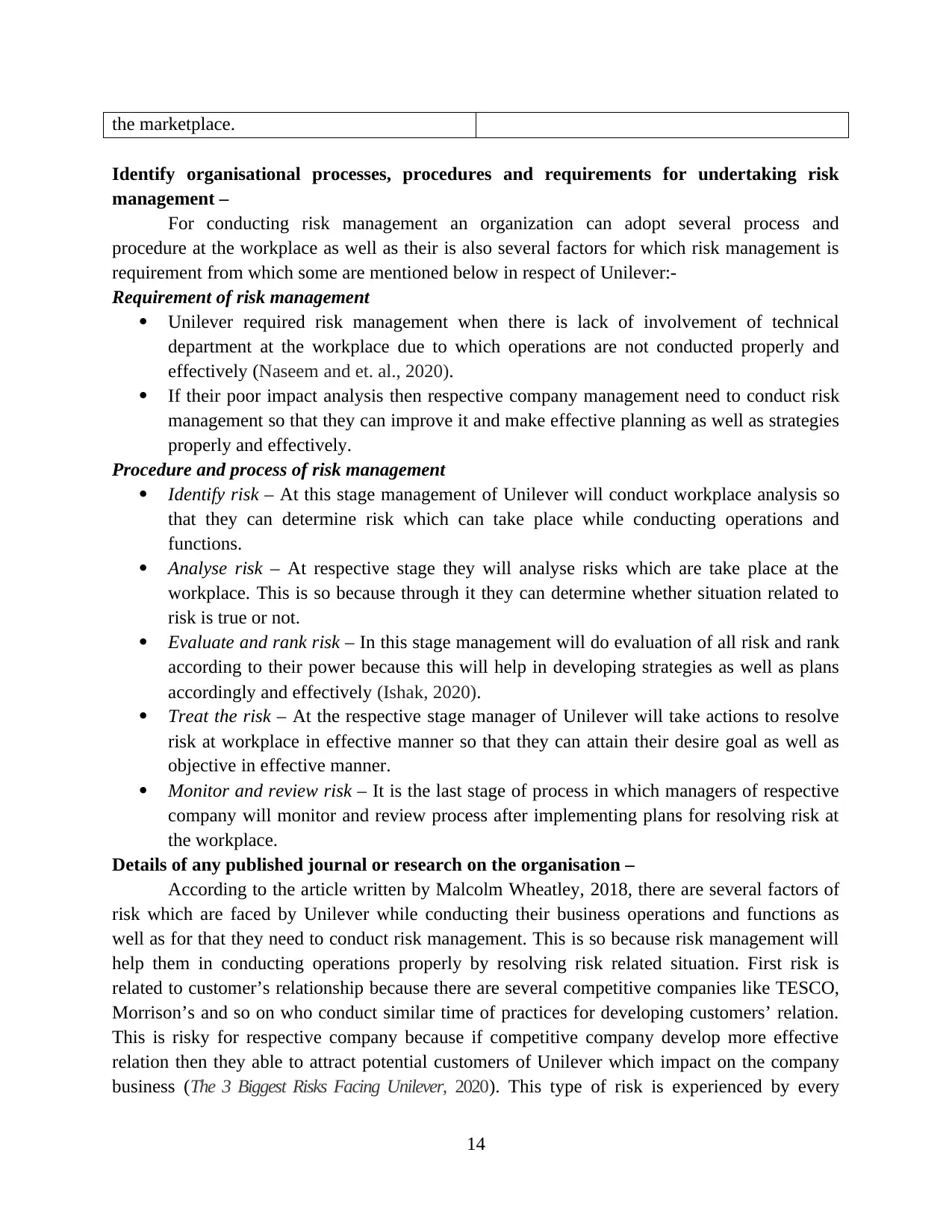
the marketplace.
Identify organisational processes, procedures and requirements for undertaking risk
management –
For conducting risk management an organization can adopt several process and
procedure at the workplace as well as their is also several factors for which risk management is
requirement from which some are mentioned below in respect of Unilever:-
Requirement of risk management
Unilever required risk management when there is lack of involvement of technical
department at the workplace due to which operations are not conducted properly and
effectively (Naseem and et. al., 2020).
If their poor impact analysis then respective company management need to conduct risk
management so that they can improve it and make effective planning as well as strategies
properly and effectively.
Procedure and process of risk management
Identify risk – At this stage management of Unilever will conduct workplace analysis so
that they can determine risk which can take place while conducting operations and
functions.
Analyse risk – At respective stage they will analyse risks which are take place at the
workplace. This is so because through it they can determine whether situation related to
risk is true or not.
Evaluate and rank risk – In this stage management will do evaluation of all risk and rank
according to their power because this will help in developing strategies as well as plans
accordingly and effectively (Ishak, 2020).
Treat the risk – At the respective stage manager of Unilever will take actions to resolve
risk at workplace in effective manner so that they can attain their desire goal as well as
objective in effective manner.
Monitor and review risk – It is the last stage of process in which managers of respective
company will monitor and review process after implementing plans for resolving risk at
the workplace.
Details of any published journal or research on the organisation –
According to the article written by Malcolm Wheatley, 2018, there are several factors of
risk which are faced by Unilever while conducting their business operations and functions as
well as for that they need to conduct risk management. This is so because risk management will
help them in conducting operations properly by resolving risk related situation. First risk is
related to customer’s relationship because there are several competitive companies like TESCO,
Morrison’s and so on who conduct similar time of practices for developing customers’ relation.
This is risky for respective company because if competitive company develop more effective
relation then they able to attract potential customers of Unilever which impact on the company
business (The 3 Biggest Risks Facing Unilever, 2020). This type of risk is experienced by every
14
Identify organisational processes, procedures and requirements for undertaking risk
management –
For conducting risk management an organization can adopt several process and
procedure at the workplace as well as their is also several factors for which risk management is
requirement from which some are mentioned below in respect of Unilever:-
Requirement of risk management
Unilever required risk management when there is lack of involvement of technical
department at the workplace due to which operations are not conducted properly and
effectively (Naseem and et. al., 2020).
If their poor impact analysis then respective company management need to conduct risk
management so that they can improve it and make effective planning as well as strategies
properly and effectively.
Procedure and process of risk management
Identify risk – At this stage management of Unilever will conduct workplace analysis so
that they can determine risk which can take place while conducting operations and
functions.
Analyse risk – At respective stage they will analyse risks which are take place at the
workplace. This is so because through it they can determine whether situation related to
risk is true or not.
Evaluate and rank risk – In this stage management will do evaluation of all risk and rank
according to their power because this will help in developing strategies as well as plans
accordingly and effectively (Ishak, 2020).
Treat the risk – At the respective stage manager of Unilever will take actions to resolve
risk at workplace in effective manner so that they can attain their desire goal as well as
objective in effective manner.
Monitor and review risk – It is the last stage of process in which managers of respective
company will monitor and review process after implementing plans for resolving risk at
the workplace.
Details of any published journal or research on the organisation –
According to the article written by Malcolm Wheatley, 2018, there are several factors of
risk which are faced by Unilever while conducting their business operations and functions as
well as for that they need to conduct risk management. This is so because risk management will
help them in conducting operations properly by resolving risk related situation. First risk is
related to customer’s relationship because there are several competitive companies like TESCO,
Morrison’s and so on who conduct similar time of practices for developing customers’ relation.
This is risky for respective company because if competitive company develop more effective
relation then they able to attract potential customers of Unilever which impact on the company
business (The 3 Biggest Risks Facing Unilever, 2020). This type of risk is experienced by every
14
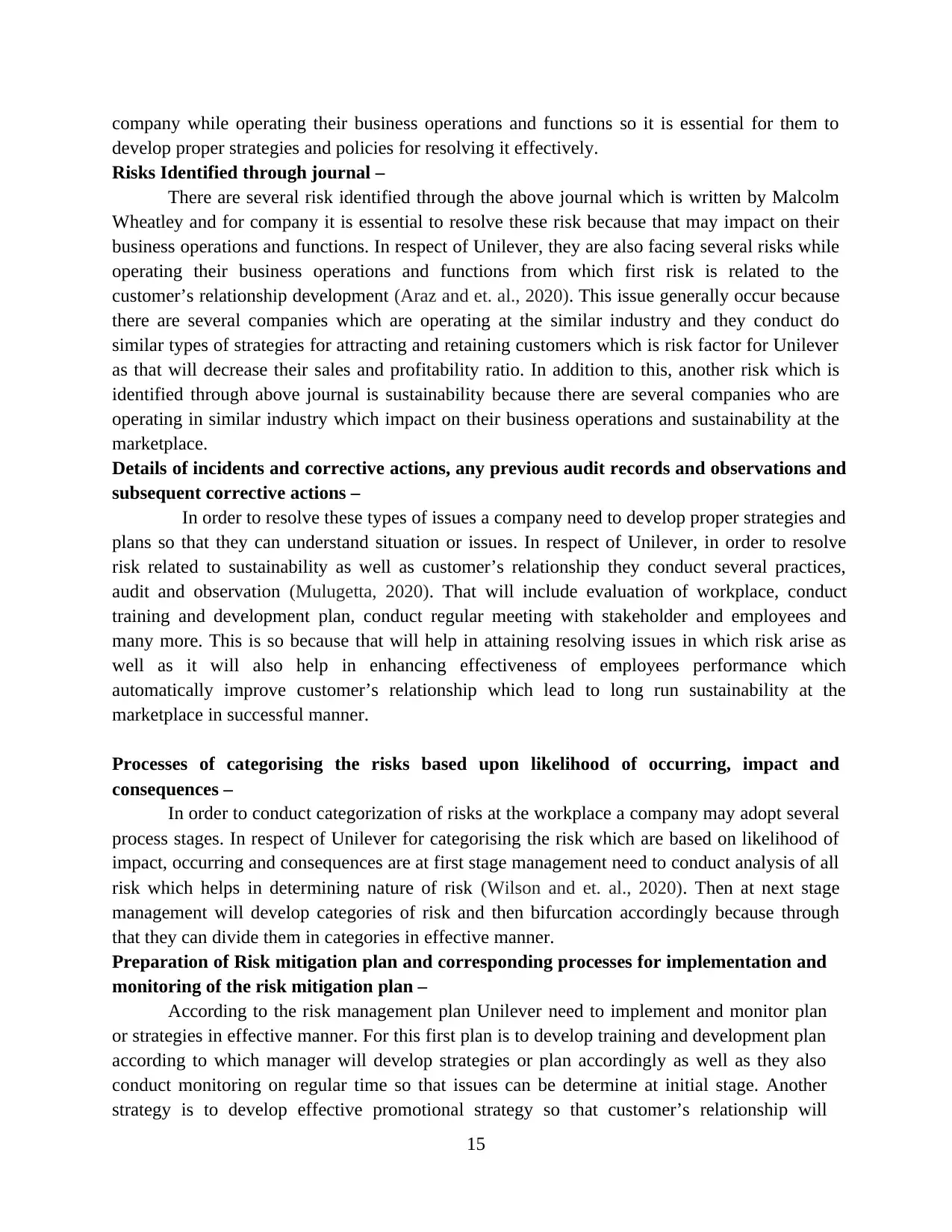
company while operating their business operations and functions so it is essential for them to
develop proper strategies and policies for resolving it effectively.
Risks Identified through journal –
There are several risk identified through the above journal which is written by Malcolm
Wheatley and for company it is essential to resolve these risk because that may impact on their
business operations and functions. In respect of Unilever, they are also facing several risks while
operating their business operations and functions from which first risk is related to the
customer’s relationship development (Araz and et. al., 2020). This issue generally occur because
there are several companies which are operating at the similar industry and they conduct do
similar types of strategies for attracting and retaining customers which is risk factor for Unilever
as that will decrease their sales and profitability ratio. In addition to this, another risk which is
identified through above journal is sustainability because there are several companies who are
operating in similar industry which impact on their business operations and sustainability at the
marketplace.
Details of incidents and corrective actions, any previous audit records and observations and
subsequent corrective actions –
In order to resolve these types of issues a company need to develop proper strategies and
plans so that they can understand situation or issues. In respect of Unilever, in order to resolve
risk related to sustainability as well as customer’s relationship they conduct several practices,
audit and observation (Mulugetta, 2020). That will include evaluation of workplace, conduct
training and development plan, conduct regular meeting with stakeholder and employees and
many more. This is so because that will help in attaining resolving issues in which risk arise as
well as it will also help in enhancing effectiveness of employees performance which
automatically improve customer’s relationship which lead to long run sustainability at the
marketplace in successful manner.
Processes of categorising the risks based upon likelihood of occurring, impact and
consequences –
In order to conduct categorization of risks at the workplace a company may adopt several
process stages. In respect of Unilever for categorising the risk which are based on likelihood of
impact, occurring and consequences are at first stage management need to conduct analysis of all
risk which helps in determining nature of risk (Wilson and et. al., 2020). Then at next stage
management will develop categories of risk and then bifurcation accordingly because through
that they can divide them in categories in effective manner.
Preparation of Risk mitigation plan and corresponding processes for implementation and
monitoring of the risk mitigation plan –
According to the risk management plan Unilever need to implement and monitor plan
or strategies in effective manner. For this first plan is to develop training and development plan
according to which manager will develop strategies or plan accordingly as well as they also
conduct monitoring on regular time so that issues can be determine at initial stage. Another
strategy is to develop effective promotional strategy so that customer’s relationship will
15
develop proper strategies and policies for resolving it effectively.
Risks Identified through journal –
There are several risk identified through the above journal which is written by Malcolm
Wheatley and for company it is essential to resolve these risk because that may impact on their
business operations and functions. In respect of Unilever, they are also facing several risks while
operating their business operations and functions from which first risk is related to the
customer’s relationship development (Araz and et. al., 2020). This issue generally occur because
there are several companies which are operating at the similar industry and they conduct do
similar types of strategies for attracting and retaining customers which is risk factor for Unilever
as that will decrease their sales and profitability ratio. In addition to this, another risk which is
identified through above journal is sustainability because there are several companies who are
operating in similar industry which impact on their business operations and sustainability at the
marketplace.
Details of incidents and corrective actions, any previous audit records and observations and
subsequent corrective actions –
In order to resolve these types of issues a company need to develop proper strategies and
plans so that they can understand situation or issues. In respect of Unilever, in order to resolve
risk related to sustainability as well as customer’s relationship they conduct several practices,
audit and observation (Mulugetta, 2020). That will include evaluation of workplace, conduct
training and development plan, conduct regular meeting with stakeholder and employees and
many more. This is so because that will help in attaining resolving issues in which risk arise as
well as it will also help in enhancing effectiveness of employees performance which
automatically improve customer’s relationship which lead to long run sustainability at the
marketplace in successful manner.
Processes of categorising the risks based upon likelihood of occurring, impact and
consequences –
In order to conduct categorization of risks at the workplace a company may adopt several
process stages. In respect of Unilever for categorising the risk which are based on likelihood of
impact, occurring and consequences are at first stage management need to conduct analysis of all
risk which helps in determining nature of risk (Wilson and et. al., 2020). Then at next stage
management will develop categories of risk and then bifurcation accordingly because through
that they can divide them in categories in effective manner.
Preparation of Risk mitigation plan and corresponding processes for implementation and
monitoring of the risk mitigation plan –
According to the risk management plan Unilever need to implement and monitor plan
or strategies in effective manner. For this first plan is to develop training and development plan
according to which manager will develop strategies or plan accordingly as well as they also
conduct monitoring on regular time so that issues can be determine at initial stage. Another
strategy is to develop effective promotional strategy so that customer’s relationship will
15
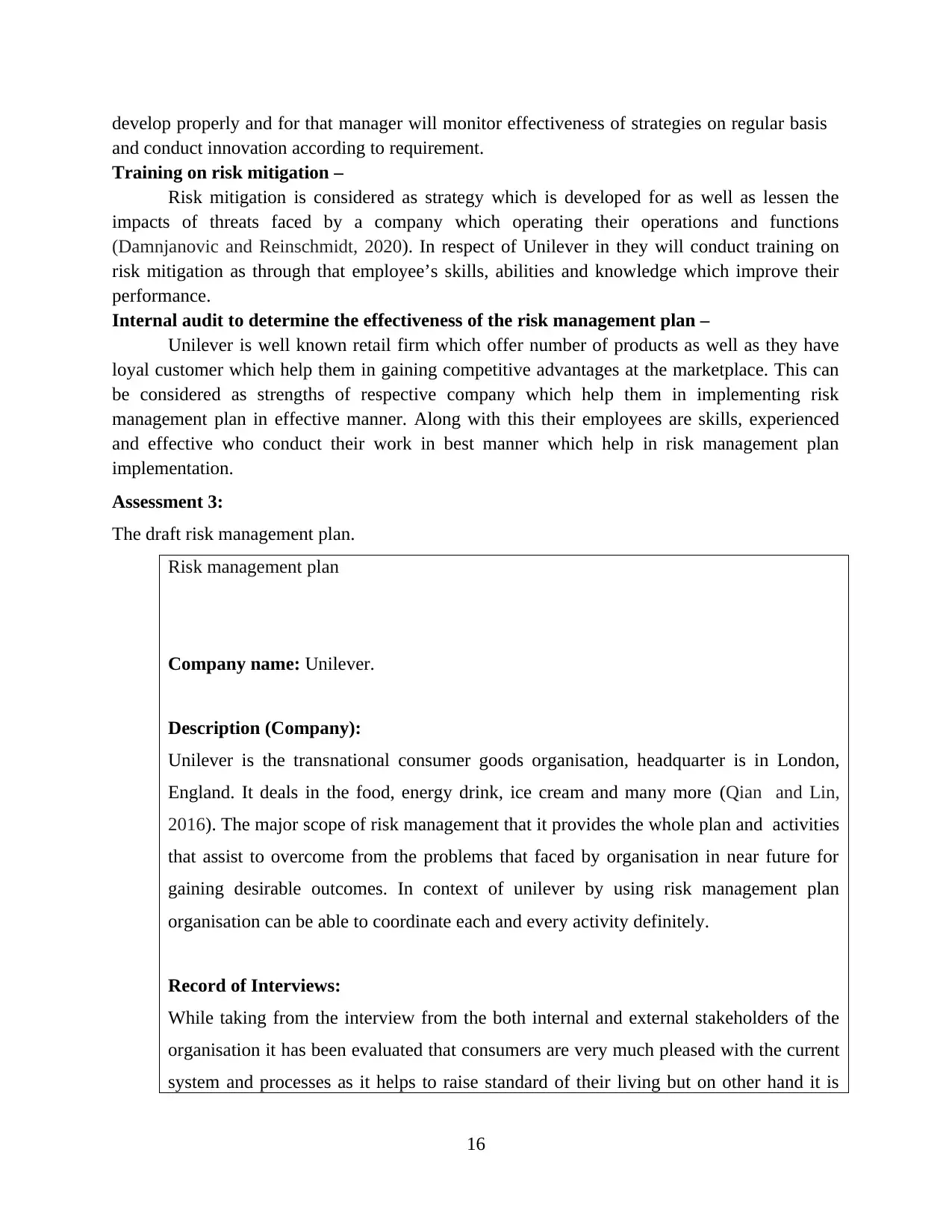
develop properly and for that manager will monitor effectiveness of strategies on regular basis
and conduct innovation according to requirement.
Training on risk mitigation –
Risk mitigation is considered as strategy which is developed for as well as lessen the
impacts of threats faced by a company which operating their operations and functions
(Damnjanovic and Reinschmidt, 2020). In respect of Unilever in they will conduct training on
risk mitigation as through that employee’s skills, abilities and knowledge which improve their
performance.
Internal audit to determine the effectiveness of the risk management plan –
Unilever is well known retail firm which offer number of products as well as they have
loyal customer which help them in gaining competitive advantages at the marketplace. This can
be considered as strengths of respective company which help them in implementing risk
management plan in effective manner. Along with this their employees are skills, experienced
and effective who conduct their work in best manner which help in risk management plan
implementation.
Assessment 3:
The draft risk management plan.
Risk management plan
Company name: Unilever.
Description (Company):
Unilever is the transnational consumer goods organisation, headquarter is in London,
England. It deals in the food, energy drink, ice cream and many more (Qian and Lin,
2016). The major scope of risk management that it provides the whole plan and activities
that assist to overcome from the problems that faced by organisation in near future for
gaining desirable outcomes. In context of unilever by using risk management plan
organisation can be able to coordinate each and every activity definitely.
Record of Interviews:
While taking from the interview from the both internal and external stakeholders of the
organisation it has been evaluated that consumers are very much pleased with the current
system and processes as it helps to raise standard of their living but on other hand it is
16
and conduct innovation according to requirement.
Training on risk mitigation –
Risk mitigation is considered as strategy which is developed for as well as lessen the
impacts of threats faced by a company which operating their operations and functions
(Damnjanovic and Reinschmidt, 2020). In respect of Unilever in they will conduct training on
risk mitigation as through that employee’s skills, abilities and knowledge which improve their
performance.
Internal audit to determine the effectiveness of the risk management plan –
Unilever is well known retail firm which offer number of products as well as they have
loyal customer which help them in gaining competitive advantages at the marketplace. This can
be considered as strengths of respective company which help them in implementing risk
management plan in effective manner. Along with this their employees are skills, experienced
and effective who conduct their work in best manner which help in risk management plan
implementation.
Assessment 3:
The draft risk management plan.
Risk management plan
Company name: Unilever.
Description (Company):
Unilever is the transnational consumer goods organisation, headquarter is in London,
England. It deals in the food, energy drink, ice cream and many more (Qian and Lin,
2016). The major scope of risk management that it provides the whole plan and activities
that assist to overcome from the problems that faced by organisation in near future for
gaining desirable outcomes. In context of unilever by using risk management plan
organisation can be able to coordinate each and every activity definitely.
Record of Interviews:
While taking from the interview from the both internal and external stakeholders of the
organisation it has been evaluated that consumers are very much pleased with the current
system and processes as it helps to raise standard of their living but on other hand it is
16
Paraphrase This Document
Need a fresh take? Get an instant paraphrase of this document with our AI Paraphraser
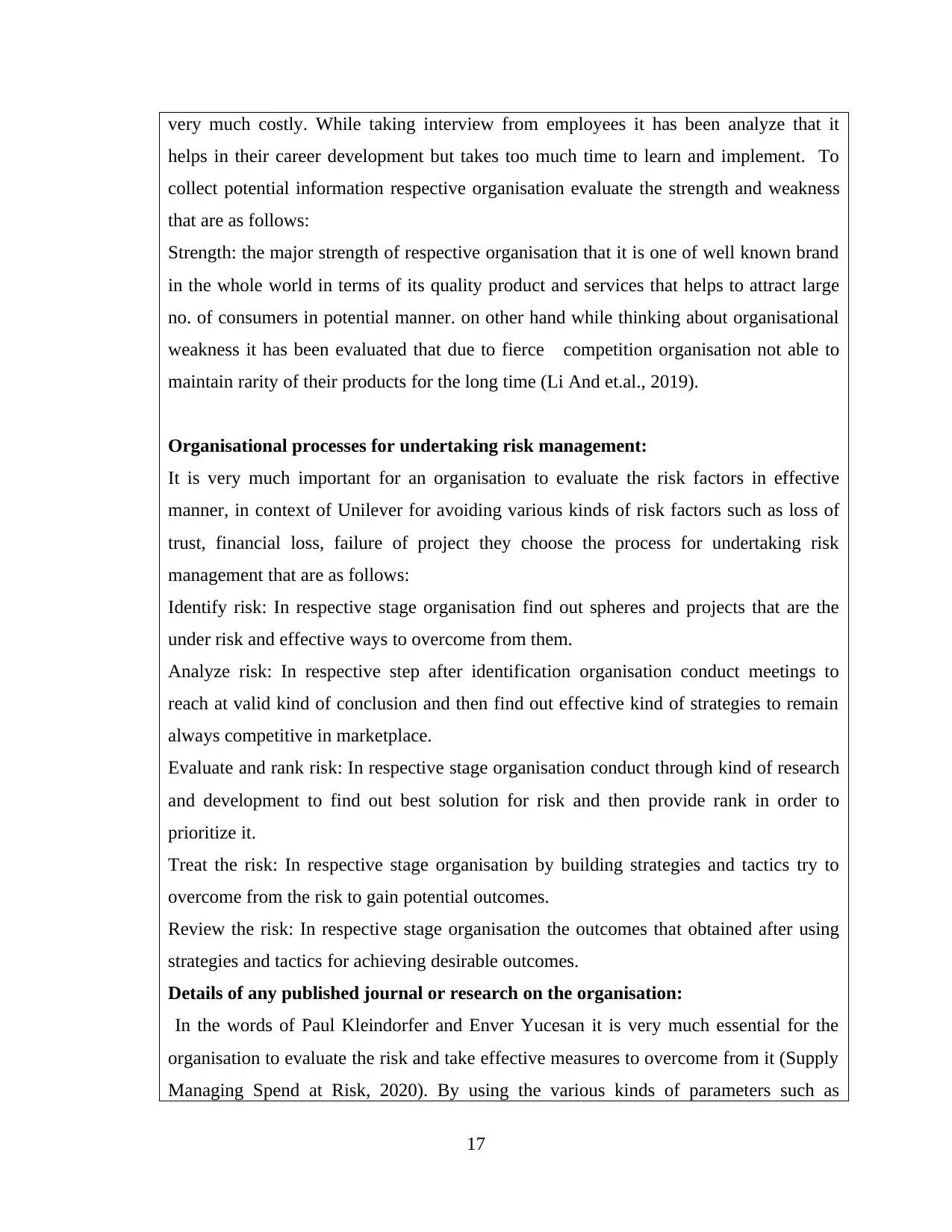
very much costly. While taking interview from employees it has been analyze that it
helps in their career development but takes too much time to learn and implement. To
collect potential information respective organisation evaluate the strength and weakness
that are as follows:
Strength: the major strength of respective organisation that it is one of well known brand
in the whole world in terms of its quality product and services that helps to attract large
no. of consumers in potential manner. on other hand while thinking about organisational
weakness it has been evaluated that due to fierce competition organisation not able to
maintain rarity of their products for the long time (Li And et.al., 2019).
Organisational processes for undertaking risk management:
It is very much important for an organisation to evaluate the risk factors in effective
manner, in context of Unilever for avoiding various kinds of risk factors such as loss of
trust, financial loss, failure of project they choose the process for undertaking risk
management that are as follows:
Identify risk: In respective stage organisation find out spheres and projects that are the
under risk and effective ways to overcome from them.
Analyze risk: In respective step after identification organisation conduct meetings to
reach at valid kind of conclusion and then find out effective kind of strategies to remain
always competitive in marketplace.
Evaluate and rank risk: In respective stage organisation conduct through kind of research
and development to find out best solution for risk and then provide rank in order to
prioritize it.
Treat the risk: In respective stage organisation by building strategies and tactics try to
overcome from the risk to gain potential outcomes.
Review the risk: In respective stage organisation the outcomes that obtained after using
strategies and tactics for achieving desirable outcomes.
Details of any published journal or research on the organisation:
In the words of Paul Kleindorfer and Enver Yucesan it is very much essential for the
organisation to evaluate the risk and take effective measures to overcome from it (Supply
Managing Spend at Risk, 2020). By using the various kinds of parameters such as
17
helps in their career development but takes too much time to learn and implement. To
collect potential information respective organisation evaluate the strength and weakness
that are as follows:
Strength: the major strength of respective organisation that it is one of well known brand
in the whole world in terms of its quality product and services that helps to attract large
no. of consumers in potential manner. on other hand while thinking about organisational
weakness it has been evaluated that due to fierce competition organisation not able to
maintain rarity of their products for the long time (Li And et.al., 2019).
Organisational processes for undertaking risk management:
It is very much important for an organisation to evaluate the risk factors in effective
manner, in context of Unilever for avoiding various kinds of risk factors such as loss of
trust, financial loss, failure of project they choose the process for undertaking risk
management that are as follows:
Identify risk: In respective stage organisation find out spheres and projects that are the
under risk and effective ways to overcome from them.
Analyze risk: In respective step after identification organisation conduct meetings to
reach at valid kind of conclusion and then find out effective kind of strategies to remain
always competitive in marketplace.
Evaluate and rank risk: In respective stage organisation conduct through kind of research
and development to find out best solution for risk and then provide rank in order to
prioritize it.
Treat the risk: In respective stage organisation by building strategies and tactics try to
overcome from the risk to gain potential outcomes.
Review the risk: In respective stage organisation the outcomes that obtained after using
strategies and tactics for achieving desirable outcomes.
Details of any published journal or research on the organisation:
In the words of Paul Kleindorfer and Enver Yucesan it is very much essential for the
organisation to evaluate the risk and take effective measures to overcome from it (Supply
Managing Spend at Risk, 2020). By using the various kinds of parameters such as
17
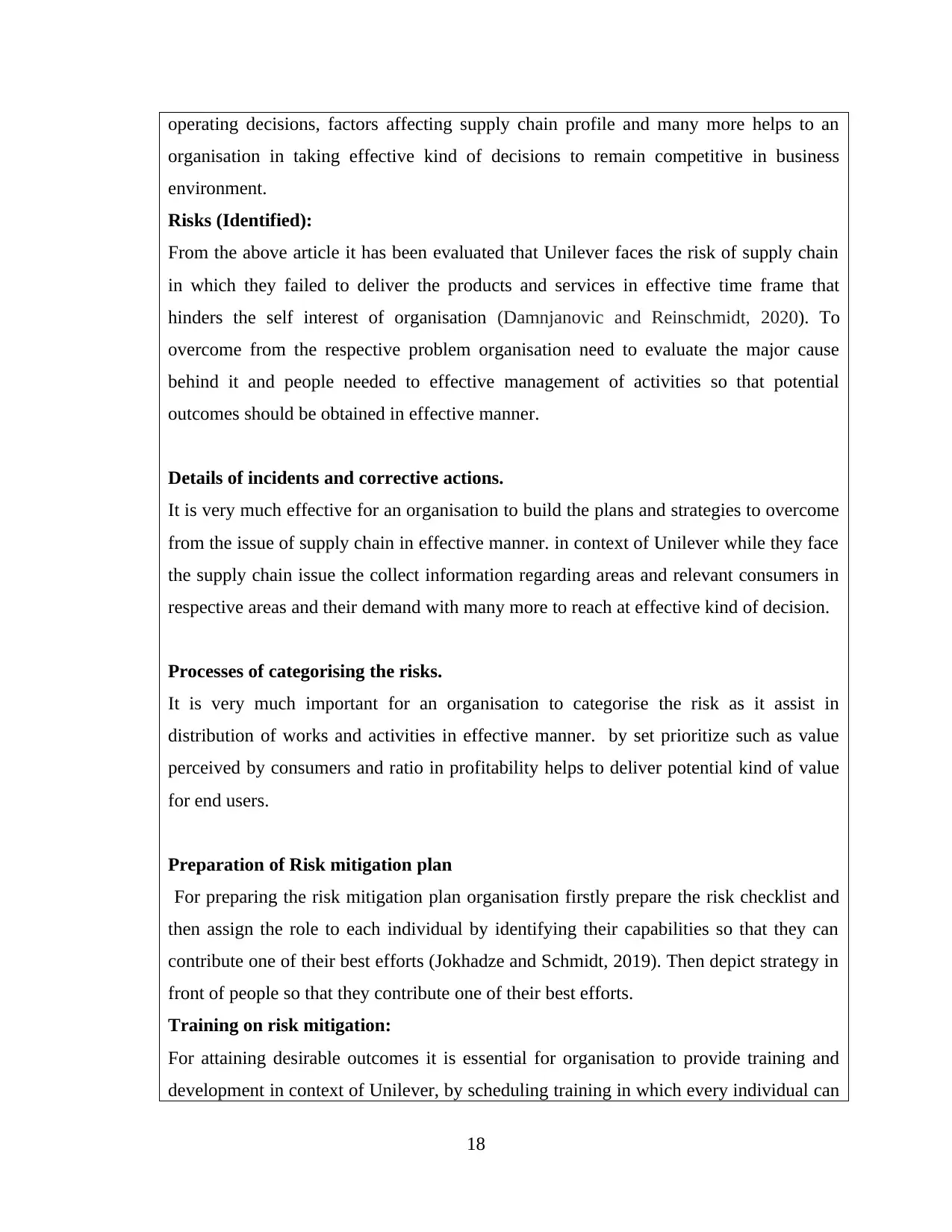
operating decisions, factors affecting supply chain profile and many more helps to an
organisation in taking effective kind of decisions to remain competitive in business
environment.
Risks (Identified):
From the above article it has been evaluated that Unilever faces the risk of supply chain
in which they failed to deliver the products and services in effective time frame that
hinders the self interest of organisation (Damnjanovic and Reinschmidt, 2020). To
overcome from the respective problem organisation need to evaluate the major cause
behind it and people needed to effective management of activities so that potential
outcomes should be obtained in effective manner.
Details of incidents and corrective actions.
It is very much effective for an organisation to build the plans and strategies to overcome
from the issue of supply chain in effective manner. in context of Unilever while they face
the supply chain issue the collect information regarding areas and relevant consumers in
respective areas and their demand with many more to reach at effective kind of decision.
Processes of categorising the risks.
It is very much important for an organisation to categorise the risk as it assist in
distribution of works and activities in effective manner. by set prioritize such as value
perceived by consumers and ratio in profitability helps to deliver potential kind of value
for end users.
Preparation of Risk mitigation plan
For preparing the risk mitigation plan organisation firstly prepare the risk checklist and
then assign the role to each individual by identifying their capabilities so that they can
contribute one of their best efforts (Jokhadze and Schmidt, 2019). Then depict strategy in
front of people so that they contribute one of their best efforts.
Training on risk mitigation:
For attaining desirable outcomes it is essential for organisation to provide training and
development in context of Unilever, by scheduling training in which every individual can
18
organisation in taking effective kind of decisions to remain competitive in business
environment.
Risks (Identified):
From the above article it has been evaluated that Unilever faces the risk of supply chain
in which they failed to deliver the products and services in effective time frame that
hinders the self interest of organisation (Damnjanovic and Reinschmidt, 2020). To
overcome from the respective problem organisation need to evaluate the major cause
behind it and people needed to effective management of activities so that potential
outcomes should be obtained in effective manner.
Details of incidents and corrective actions.
It is very much effective for an organisation to build the plans and strategies to overcome
from the issue of supply chain in effective manner. in context of Unilever while they face
the supply chain issue the collect information regarding areas and relevant consumers in
respective areas and their demand with many more to reach at effective kind of decision.
Processes of categorising the risks.
It is very much important for an organisation to categorise the risk as it assist in
distribution of works and activities in effective manner. by set prioritize such as value
perceived by consumers and ratio in profitability helps to deliver potential kind of value
for end users.
Preparation of Risk mitigation plan
For preparing the risk mitigation plan organisation firstly prepare the risk checklist and
then assign the role to each individual by identifying their capabilities so that they can
contribute one of their best efforts (Jokhadze and Schmidt, 2019). Then depict strategy in
front of people so that they contribute one of their best efforts.
Training on risk mitigation:
For attaining desirable outcomes it is essential for organisation to provide training and
development in context of Unilever, by scheduling training in which every individual can
18
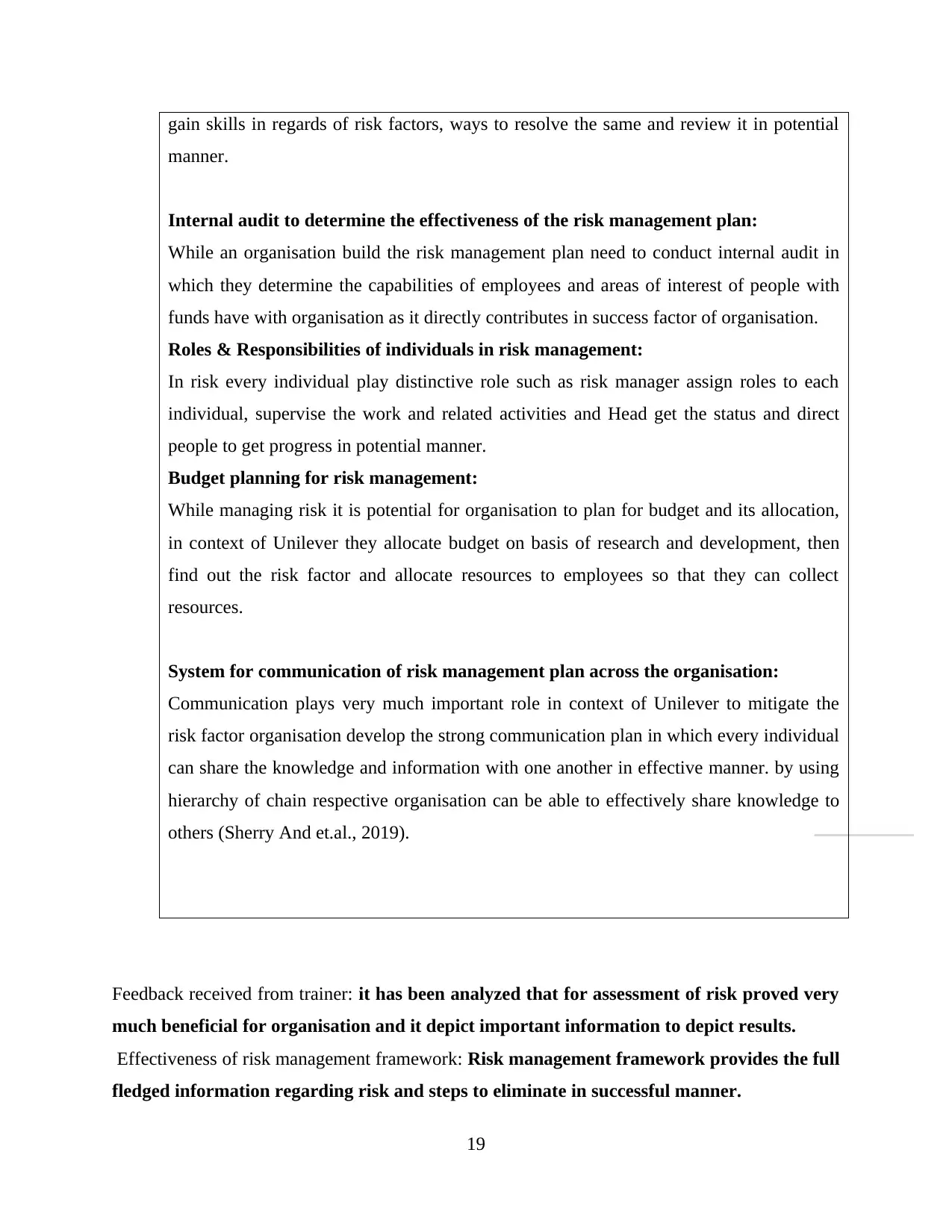
gain skills in regards of risk factors, ways to resolve the same and review it in potential
manner.
Internal audit to determine the effectiveness of the risk management plan:
While an organisation build the risk management plan need to conduct internal audit in
which they determine the capabilities of employees and areas of interest of people with
funds have with organisation as it directly contributes in success factor of organisation.
Roles & Responsibilities of individuals in risk management:
In risk every individual play distinctive role such as risk manager assign roles to each
individual, supervise the work and related activities and Head get the status and direct
people to get progress in potential manner.
Budget planning for risk management:
While managing risk it is potential for organisation to plan for budget and its allocation,
in context of Unilever they allocate budget on basis of research and development, then
find out the risk factor and allocate resources to employees so that they can collect
resources.
System for communication of risk management plan across the organisation:
Communication plays very much important role in context of Unilever to mitigate the
risk factor organisation develop the strong communication plan in which every individual
can share the knowledge and information with one another in effective manner. by using
hierarchy of chain respective organisation can be able to effectively share knowledge to
others (Sherry And et.al., 2019).
Feedback received from trainer: it has been analyzed that for assessment of risk proved very
much beneficial for organisation and it depict important information to depict results.
Effectiveness of risk management framework: Risk management framework provides the full
fledged information regarding risk and steps to eliminate in successful manner.
19
manner.
Internal audit to determine the effectiveness of the risk management plan:
While an organisation build the risk management plan need to conduct internal audit in
which they determine the capabilities of employees and areas of interest of people with
funds have with organisation as it directly contributes in success factor of organisation.
Roles & Responsibilities of individuals in risk management:
In risk every individual play distinctive role such as risk manager assign roles to each
individual, supervise the work and related activities and Head get the status and direct
people to get progress in potential manner.
Budget planning for risk management:
While managing risk it is potential for organisation to plan for budget and its allocation,
in context of Unilever they allocate budget on basis of research and development, then
find out the risk factor and allocate resources to employees so that they can collect
resources.
System for communication of risk management plan across the organisation:
Communication plays very much important role in context of Unilever to mitigate the
risk factor organisation develop the strong communication plan in which every individual
can share the knowledge and information with one another in effective manner. by using
hierarchy of chain respective organisation can be able to effectively share knowledge to
others (Sherry And et.al., 2019).
Feedback received from trainer: it has been analyzed that for assessment of risk proved very
much beneficial for organisation and it depict important information to depict results.
Effectiveness of risk management framework: Risk management framework provides the full
fledged information regarding risk and steps to eliminate in successful manner.
19
Secure Best Marks with AI Grader
Need help grading? Try our AI Grader for instant feedback on your assignments.
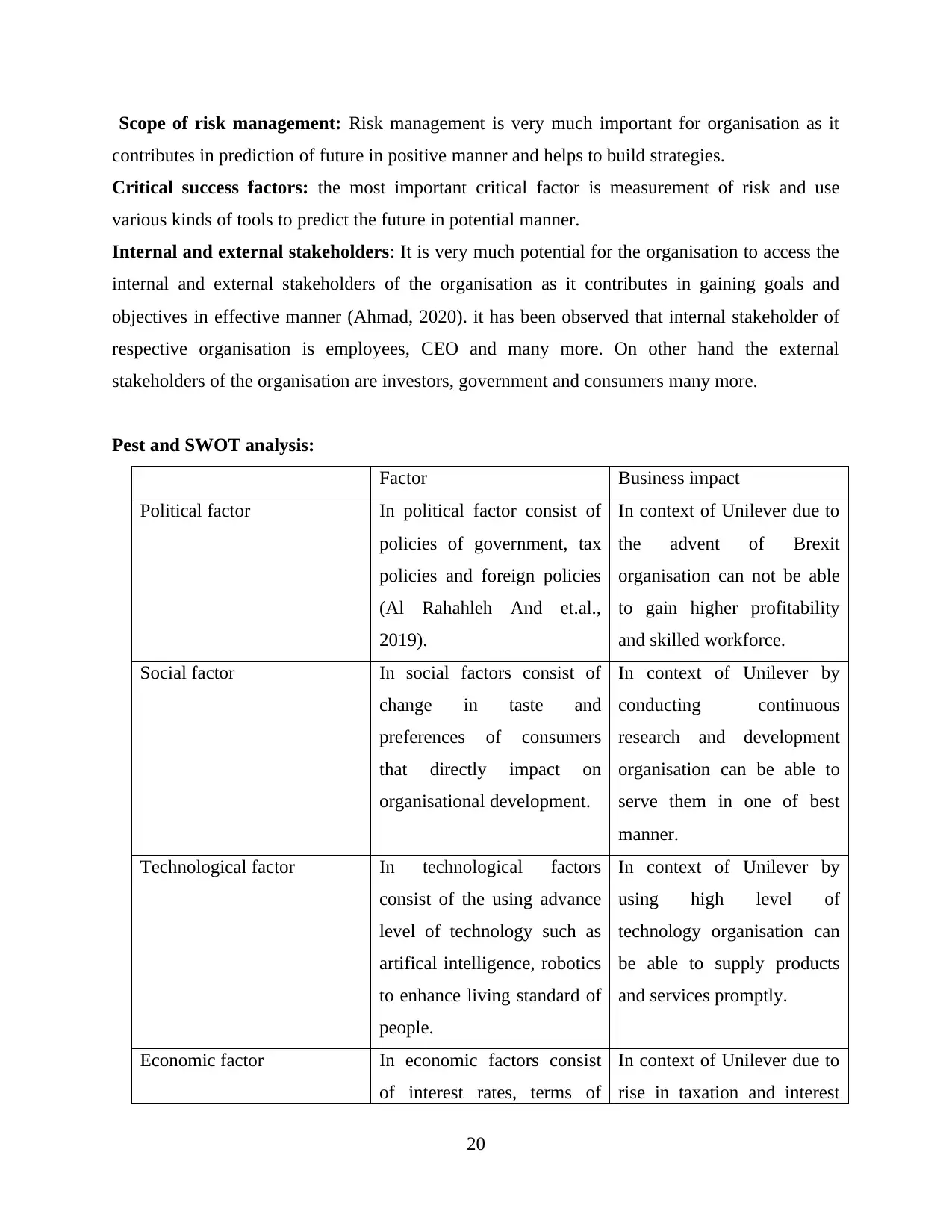
Scope of risk management: Risk management is very much important for organisation as it
contributes in prediction of future in positive manner and helps to build strategies.
Critical success factors: the most important critical factor is measurement of risk and use
various kinds of tools to predict the future in potential manner.
Internal and external stakeholders: It is very much potential for the organisation to access the
internal and external stakeholders of the organisation as it contributes in gaining goals and
objectives in effective manner (Ahmad, 2020). it has been observed that internal stakeholder of
respective organisation is employees, CEO and many more. On other hand the external
stakeholders of the organisation are investors, government and consumers many more.
Pest and SWOT analysis:
Factor Business impact
Political factor In political factor consist of
policies of government, tax
policies and foreign policies
(Al Rahahleh And et.al.,
2019).
In context of Unilever due to
the advent of Brexit
organisation can not be able
to gain higher profitability
and skilled workforce.
Social factor In social factors consist of
change in taste and
preferences of consumers
that directly impact on
organisational development.
In context of Unilever by
conducting continuous
research and development
organisation can be able to
serve them in one of best
manner.
Technological factor In technological factors
consist of the using advance
level of technology such as
artifical intelligence, robotics
to enhance living standard of
people.
In context of Unilever by
using high level of
technology organisation can
be able to supply products
and services promptly.
Economic factor In economic factors consist
of interest rates, terms of
In context of Unilever due to
rise in taxation and interest
20
contributes in prediction of future in positive manner and helps to build strategies.
Critical success factors: the most important critical factor is measurement of risk and use
various kinds of tools to predict the future in potential manner.
Internal and external stakeholders: It is very much potential for the organisation to access the
internal and external stakeholders of the organisation as it contributes in gaining goals and
objectives in effective manner (Ahmad, 2020). it has been observed that internal stakeholder of
respective organisation is employees, CEO and many more. On other hand the external
stakeholders of the organisation are investors, government and consumers many more.
Pest and SWOT analysis:
Factor Business impact
Political factor In political factor consist of
policies of government, tax
policies and foreign policies
(Al Rahahleh And et.al.,
2019).
In context of Unilever due to
the advent of Brexit
organisation can not be able
to gain higher profitability
and skilled workforce.
Social factor In social factors consist of
change in taste and
preferences of consumers
that directly impact on
organisational development.
In context of Unilever by
conducting continuous
research and development
organisation can be able to
serve them in one of best
manner.
Technological factor In technological factors
consist of the using advance
level of technology such as
artifical intelligence, robotics
to enhance living standard of
people.
In context of Unilever by
using high level of
technology organisation can
be able to supply products
and services promptly.
Economic factor In economic factors consist
of interest rates, terms of
In context of Unilever due to
rise in taxation and interest
20
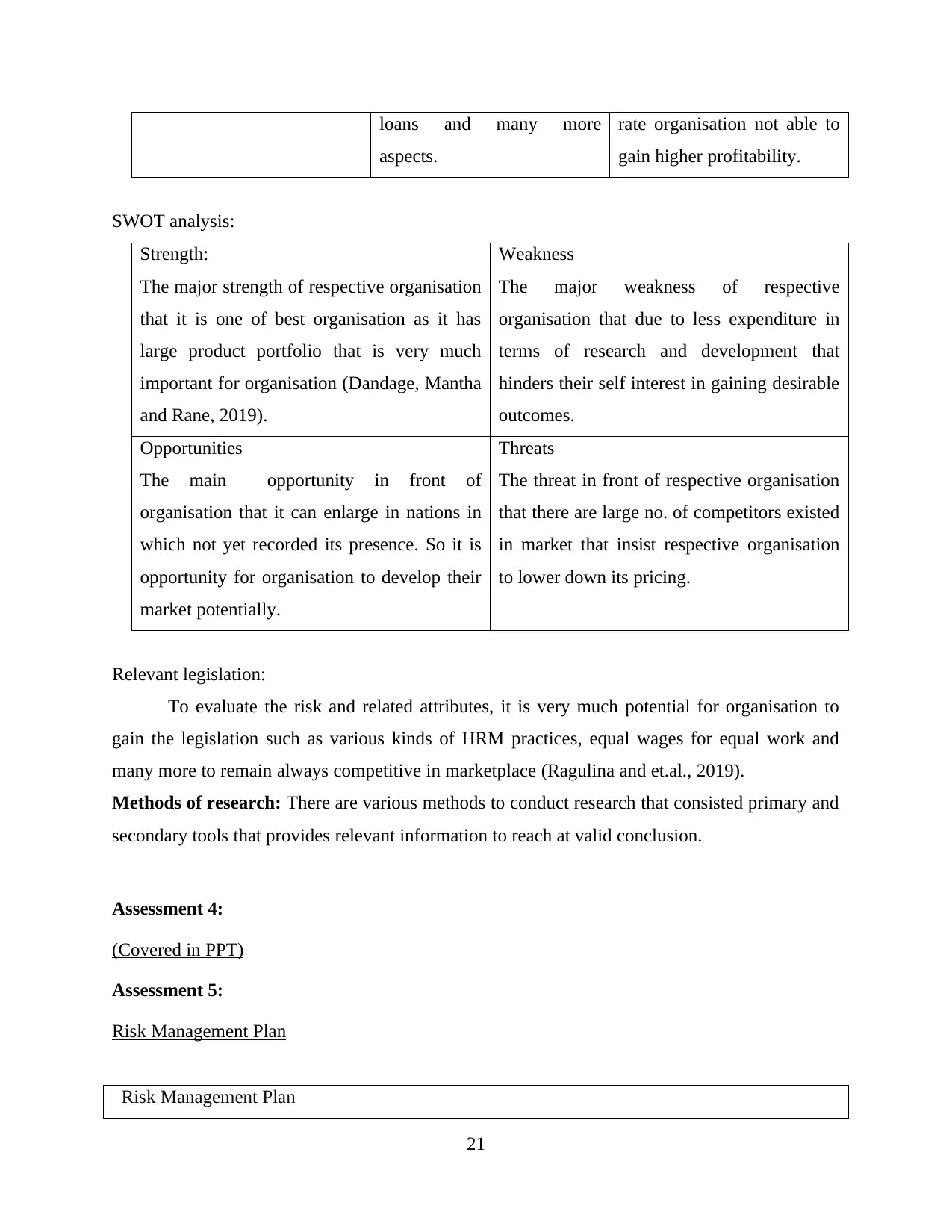
loans and many more
aspects.
rate organisation not able to
gain higher profitability.
SWOT analysis:
Strength:
The major strength of respective organisation
that it is one of best organisation as it has
large product portfolio that is very much
important for organisation (Dandage, Mantha
and Rane, 2019).
Weakness
The major weakness of respective
organisation that due to less expenditure in
terms of research and development that
hinders their self interest in gaining desirable
outcomes.
Opportunities
The main opportunity in front of
organisation that it can enlarge in nations in
which not yet recorded its presence. So it is
opportunity for organisation to develop their
market potentially.
Threats
The threat in front of respective organisation
that there are large no. of competitors existed
in market that insist respective organisation
to lower down its pricing.
Relevant legislation:
To evaluate the risk and related attributes, it is very much potential for organisation to
gain the legislation such as various kinds of HRM practices, equal wages for equal work and
many more to remain always competitive in marketplace (Ragulina and et.al., 2019).
Methods of research: There are various methods to conduct research that consisted primary and
secondary tools that provides relevant information to reach at valid conclusion.
Assessment 4:
(Covered in PPT)
Assessment 5:
Risk Management Plan
Risk Management Plan
21
aspects.
rate organisation not able to
gain higher profitability.
SWOT analysis:
Strength:
The major strength of respective organisation
that it is one of best organisation as it has
large product portfolio that is very much
important for organisation (Dandage, Mantha
and Rane, 2019).
Weakness
The major weakness of respective
organisation that due to less expenditure in
terms of research and development that
hinders their self interest in gaining desirable
outcomes.
Opportunities
The main opportunity in front of
organisation that it can enlarge in nations in
which not yet recorded its presence. So it is
opportunity for organisation to develop their
market potentially.
Threats
The threat in front of respective organisation
that there are large no. of competitors existed
in market that insist respective organisation
to lower down its pricing.
Relevant legislation:
To evaluate the risk and related attributes, it is very much potential for organisation to
gain the legislation such as various kinds of HRM practices, equal wages for equal work and
many more to remain always competitive in marketplace (Ragulina and et.al., 2019).
Methods of research: There are various methods to conduct research that consisted primary and
secondary tools that provides relevant information to reach at valid conclusion.
Assessment 4:
(Covered in PPT)
Assessment 5:
Risk Management Plan
Risk Management Plan
21
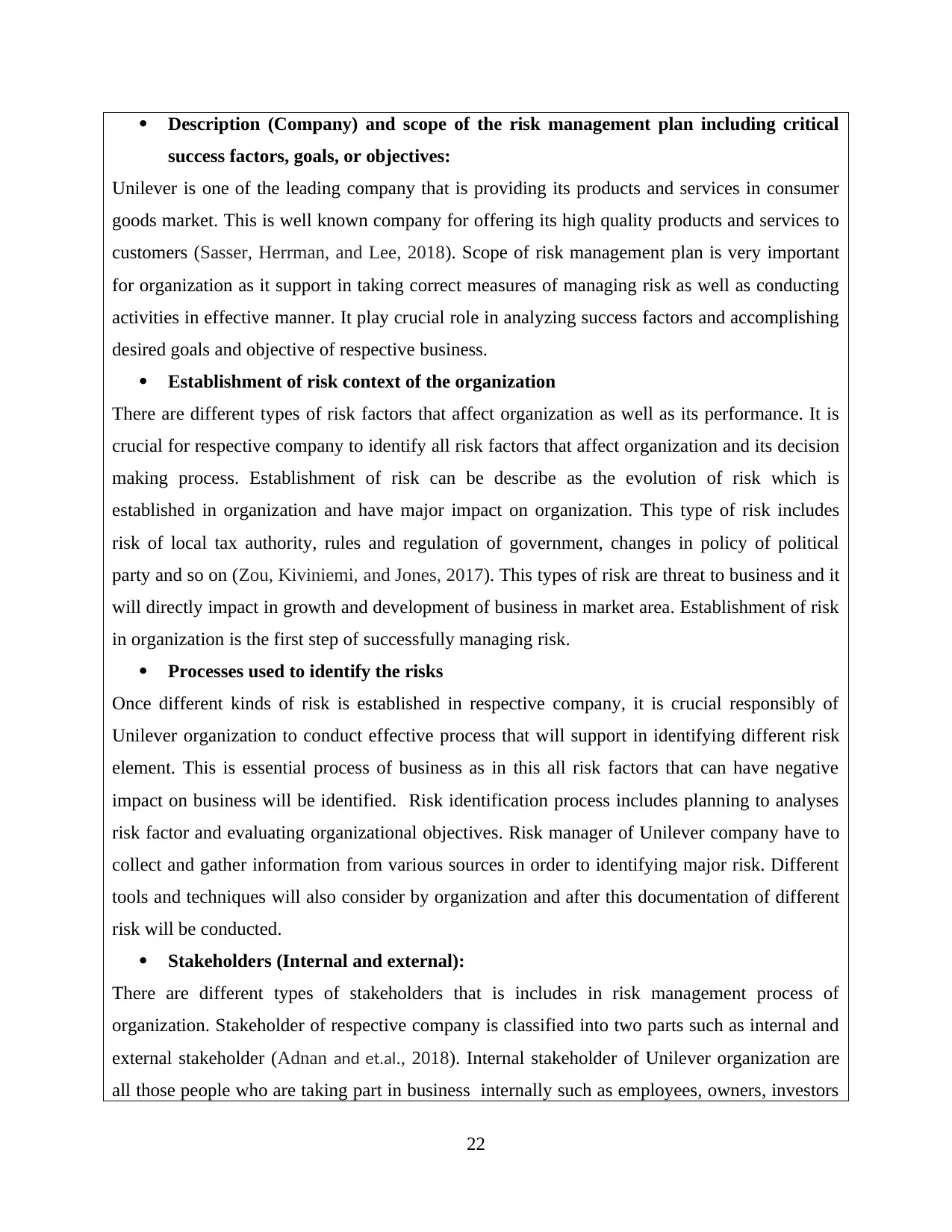
Description (Company) and scope of the risk management plan including critical
success factors, goals, or objectives:
Unilever is one of the leading company that is providing its products and services in consumer
goods market. This is well known company for offering its high quality products and services to
customers (Sasser, Herrman, and Lee, 2018). Scope of risk management plan is very important
for organization as it support in taking correct measures of managing risk as well as conducting
activities in effective manner. It play crucial role in analyzing success factors and accomplishing
desired goals and objective of respective business.
Establishment of risk context of the organization
There are different types of risk factors that affect organization as well as its performance. It is
crucial for respective company to identify all risk factors that affect organization and its decision
making process. Establishment of risk can be describe as the evolution of risk which is
established in organization and have major impact on organization. This type of risk includes
risk of local tax authority, rules and regulation of government, changes in policy of political
party and so on (Zou, Kiviniemi, and Jones, 2017). This types of risk are threat to business and it
will directly impact in growth and development of business in market area. Establishment of risk
in organization is the first step of successfully managing risk.
Processes used to identify the risks
Once different kinds of risk is established in respective company, it is crucial responsibly of
Unilever organization to conduct effective process that will support in identifying different risk
element. This is essential process of business as in this all risk factors that can have negative
impact on business will be identified. Risk identification process includes planning to analyses
risk factor and evaluating organizational objectives. Risk manager of Unilever company have to
collect and gather information from various sources in order to identifying major risk. Different
tools and techniques will also consider by organization and after this documentation of different
risk will be conducted.
Stakeholders (Internal and external):
There are different types of stakeholders that is includes in risk management process of
organization. Stakeholder of respective company is classified into two parts such as internal and
external stakeholder (Adnan and et.al., 2018). Internal stakeholder of Unilever organization are
all those people who are taking part in business internally such as employees, owners, investors
22
success factors, goals, or objectives:
Unilever is one of the leading company that is providing its products and services in consumer
goods market. This is well known company for offering its high quality products and services to
customers (Sasser, Herrman, and Lee, 2018). Scope of risk management plan is very important
for organization as it support in taking correct measures of managing risk as well as conducting
activities in effective manner. It play crucial role in analyzing success factors and accomplishing
desired goals and objective of respective business.
Establishment of risk context of the organization
There are different types of risk factors that affect organization as well as its performance. It is
crucial for respective company to identify all risk factors that affect organization and its decision
making process. Establishment of risk can be describe as the evolution of risk which is
established in organization and have major impact on organization. This type of risk includes
risk of local tax authority, rules and regulation of government, changes in policy of political
party and so on (Zou, Kiviniemi, and Jones, 2017). This types of risk are threat to business and it
will directly impact in growth and development of business in market area. Establishment of risk
in organization is the first step of successfully managing risk.
Processes used to identify the risks
Once different kinds of risk is established in respective company, it is crucial responsibly of
Unilever organization to conduct effective process that will support in identifying different risk
element. This is essential process of business as in this all risk factors that can have negative
impact on business will be identified. Risk identification process includes planning to analyses
risk factor and evaluating organizational objectives. Risk manager of Unilever company have to
collect and gather information from various sources in order to identifying major risk. Different
tools and techniques will also consider by organization and after this documentation of different
risk will be conducted.
Stakeholders (Internal and external):
There are different types of stakeholders that is includes in risk management process of
organization. Stakeholder of respective company is classified into two parts such as internal and
external stakeholder (Adnan and et.al., 2018). Internal stakeholder of Unilever organization are
all those people who are taking part in business internally such as employees, owners, investors
22
Paraphrase This Document
Need a fresh take? Get an instant paraphrase of this document with our AI Paraphraser
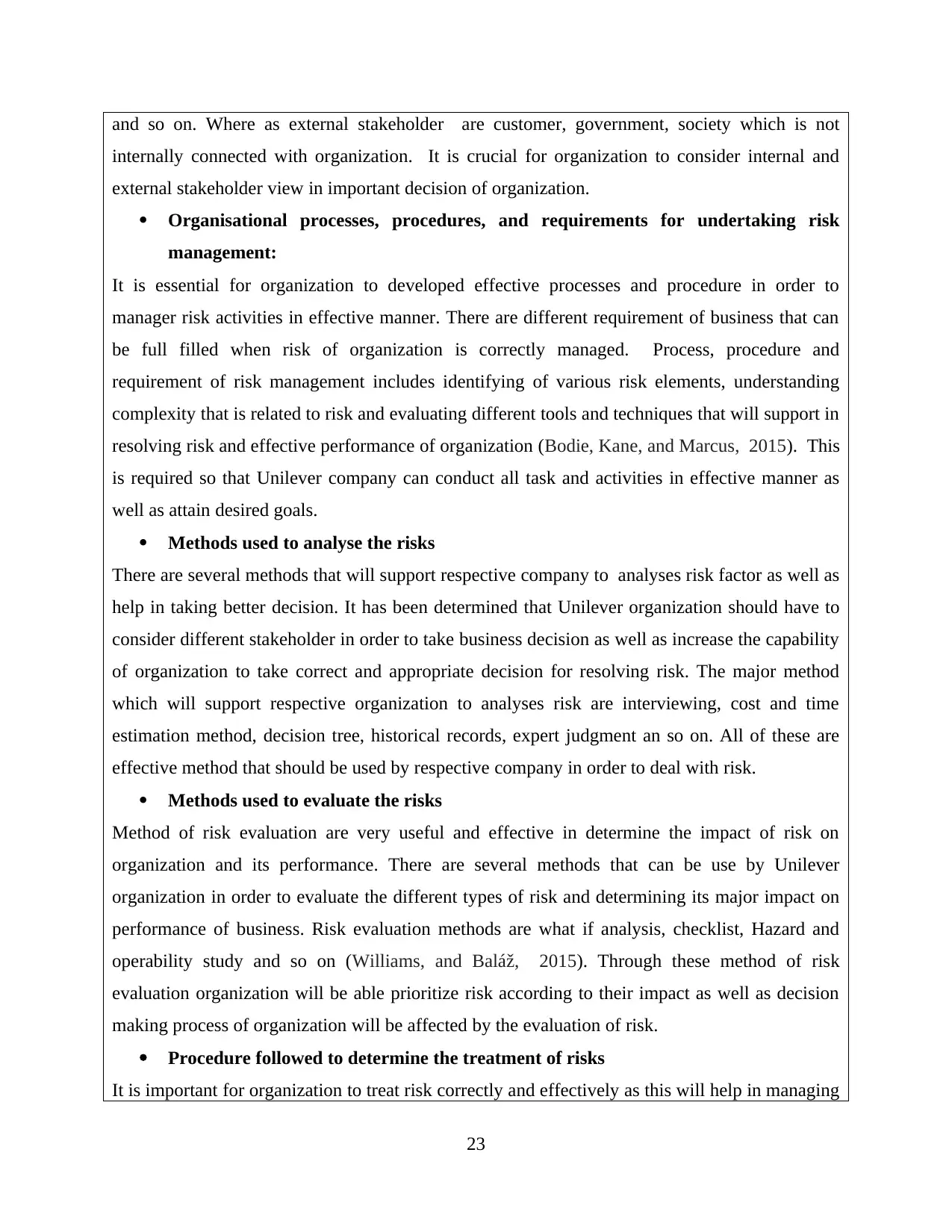
and so on. Where as external stakeholder are customer, government, society which is not
internally connected with organization. It is crucial for organization to consider internal and
external stakeholder view in important decision of organization.
Organisational processes, procedures, and requirements for undertaking risk
management:
It is essential for organization to developed effective processes and procedure in order to
manager risk activities in effective manner. There are different requirement of business that can
be full filled when risk of organization is correctly managed. Process, procedure and
requirement of risk management includes identifying of various risk elements, understanding
complexity that is related to risk and evaluating different tools and techniques that will support in
resolving risk and effective performance of organization (Bodie, Kane, and Marcus, 2015). This
is required so that Unilever company can conduct all task and activities in effective manner as
well as attain desired goals.
Methods used to analyse the risks
There are several methods that will support respective company to analyses risk factor as well as
help in taking better decision. It has been determined that Unilever organization should have to
consider different stakeholder in order to take business decision as well as increase the capability
of organization to take correct and appropriate decision for resolving risk. The major method
which will support respective organization to analyses risk are interviewing, cost and time
estimation method, decision tree, historical records, expert judgment an so on. All of these are
effective method that should be used by respective company in order to deal with risk.
Methods used to evaluate the risks
Method of risk evaluation are very useful and effective in determine the impact of risk on
organization and its performance. There are several methods that can be use by Unilever
organization in order to evaluate the different types of risk and determining its major impact on
performance of business. Risk evaluation methods are what if analysis, checklist, Hazard and
operability study and so on (Williams, and Baláž, 2015). Through these method of risk
evaluation organization will be able prioritize risk according to their impact as well as decision
making process of organization will be affected by the evaluation of risk.
Procedure followed to determine the treatment of risks
It is important for organization to treat risk correctly and effectively as this will help in managing
23
internally connected with organization. It is crucial for organization to consider internal and
external stakeholder view in important decision of organization.
Organisational processes, procedures, and requirements for undertaking risk
management:
It is essential for organization to developed effective processes and procedure in order to
manager risk activities in effective manner. There are different requirement of business that can
be full filled when risk of organization is correctly managed. Process, procedure and
requirement of risk management includes identifying of various risk elements, understanding
complexity that is related to risk and evaluating different tools and techniques that will support in
resolving risk and effective performance of organization (Bodie, Kane, and Marcus, 2015). This
is required so that Unilever company can conduct all task and activities in effective manner as
well as attain desired goals.
Methods used to analyse the risks
There are several methods that will support respective company to analyses risk factor as well as
help in taking better decision. It has been determined that Unilever organization should have to
consider different stakeholder in order to take business decision as well as increase the capability
of organization to take correct and appropriate decision for resolving risk. The major method
which will support respective organization to analyses risk are interviewing, cost and time
estimation method, decision tree, historical records, expert judgment an so on. All of these are
effective method that should be used by respective company in order to deal with risk.
Methods used to evaluate the risks
Method of risk evaluation are very useful and effective in determine the impact of risk on
organization and its performance. There are several methods that can be use by Unilever
organization in order to evaluate the different types of risk and determining its major impact on
performance of business. Risk evaluation methods are what if analysis, checklist, Hazard and
operability study and so on (Williams, and Baláž, 2015). Through these method of risk
evaluation organization will be able prioritize risk according to their impact as well as decision
making process of organization will be affected by the evaluation of risk.
Procedure followed to determine the treatment of risks
It is important for organization to treat risk correctly and effectively as this will help in managing
23
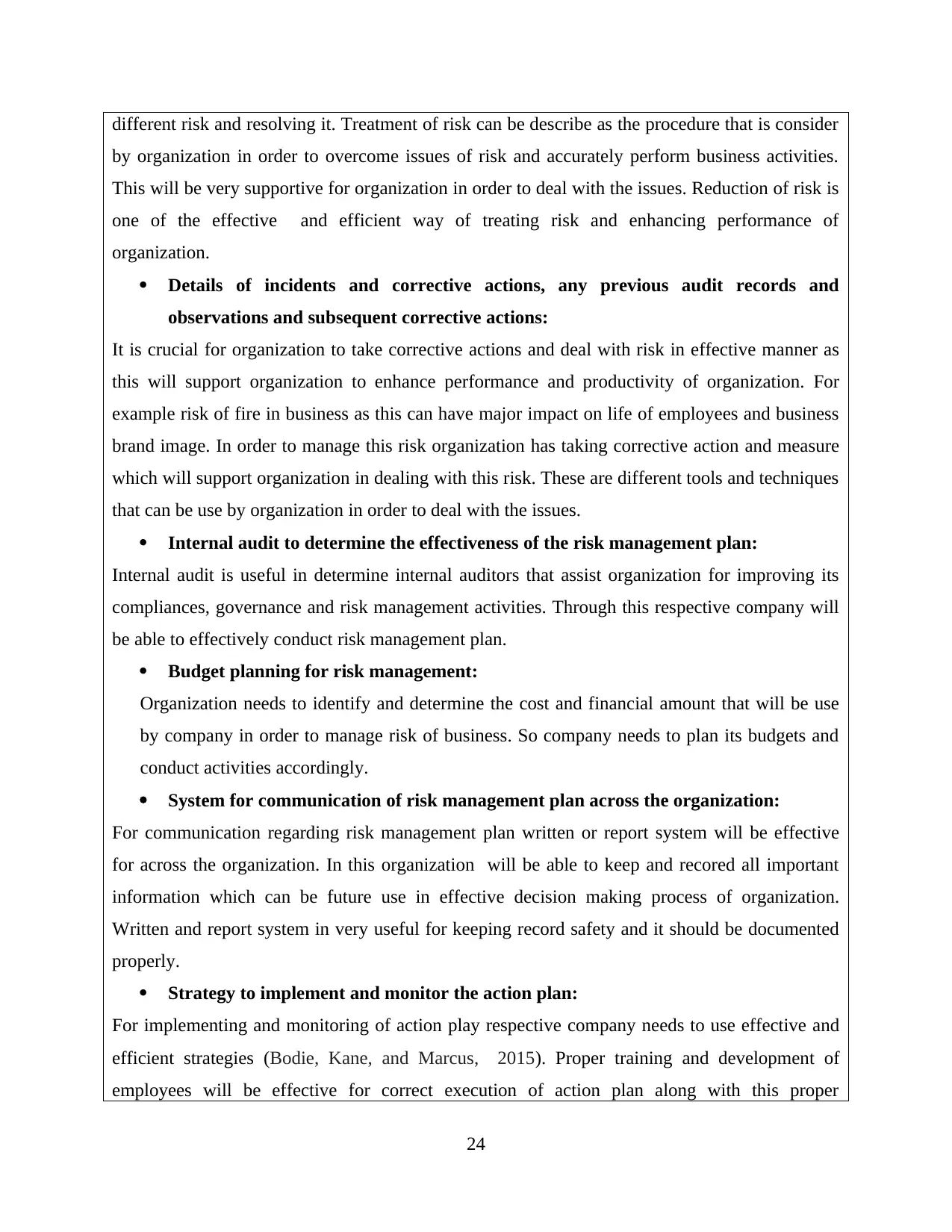
different risk and resolving it. Treatment of risk can be describe as the procedure that is consider
by organization in order to overcome issues of risk and accurately perform business activities.
This will be very supportive for organization in order to deal with the issues. Reduction of risk is
one of the effective and efficient way of treating risk and enhancing performance of
organization.
Details of incidents and corrective actions, any previous audit records and
observations and subsequent corrective actions:
It is crucial for organization to take corrective actions and deal with risk in effective manner as
this will support organization to enhance performance and productivity of organization. For
example risk of fire in business as this can have major impact on life of employees and business
brand image. In order to manage this risk organization has taking corrective action and measure
which will support organization in dealing with this risk. These are different tools and techniques
that can be use by organization in order to deal with the issues.
Internal audit to determine the effectiveness of the risk management plan:
Internal audit is useful in determine internal auditors that assist organization for improving its
compliances, governance and risk management activities. Through this respective company will
be able to effectively conduct risk management plan.
Budget planning for risk management:
Organization needs to identify and determine the cost and financial amount that will be use
by company in order to manage risk of business. So company needs to plan its budgets and
conduct activities accordingly.
System for communication of risk management plan across the organization:
For communication regarding risk management plan written or report system will be effective
for across the organization. In this organization will be able to keep and recored all important
information which can be future use in effective decision making process of organization.
Written and report system in very useful for keeping record safety and it should be documented
properly.
Strategy to implement and monitor the action plan:
For implementing and monitoring of action play respective company needs to use effective and
efficient strategies (Bodie, Kane, and Marcus, 2015). Proper training and development of
employees will be effective for correct execution of action plan along with this proper
24
by organization in order to overcome issues of risk and accurately perform business activities.
This will be very supportive for organization in order to deal with the issues. Reduction of risk is
one of the effective and efficient way of treating risk and enhancing performance of
organization.
Details of incidents and corrective actions, any previous audit records and
observations and subsequent corrective actions:
It is crucial for organization to take corrective actions and deal with risk in effective manner as
this will support organization to enhance performance and productivity of organization. For
example risk of fire in business as this can have major impact on life of employees and business
brand image. In order to manage this risk organization has taking corrective action and measure
which will support organization in dealing with this risk. These are different tools and techniques
that can be use by organization in order to deal with the issues.
Internal audit to determine the effectiveness of the risk management plan:
Internal audit is useful in determine internal auditors that assist organization for improving its
compliances, governance and risk management activities. Through this respective company will
be able to effectively conduct risk management plan.
Budget planning for risk management:
Organization needs to identify and determine the cost and financial amount that will be use
by company in order to manage risk of business. So company needs to plan its budgets and
conduct activities accordingly.
System for communication of risk management plan across the organization:
For communication regarding risk management plan written or report system will be effective
for across the organization. In this organization will be able to keep and recored all important
information which can be future use in effective decision making process of organization.
Written and report system in very useful for keeping record safety and it should be documented
properly.
Strategy to implement and monitor the action plan:
For implementing and monitoring of action play respective company needs to use effective and
efficient strategies (Bodie, Kane, and Marcus, 2015). Proper training and development of
employees will be effective for correct execution of action plan along with this proper
24
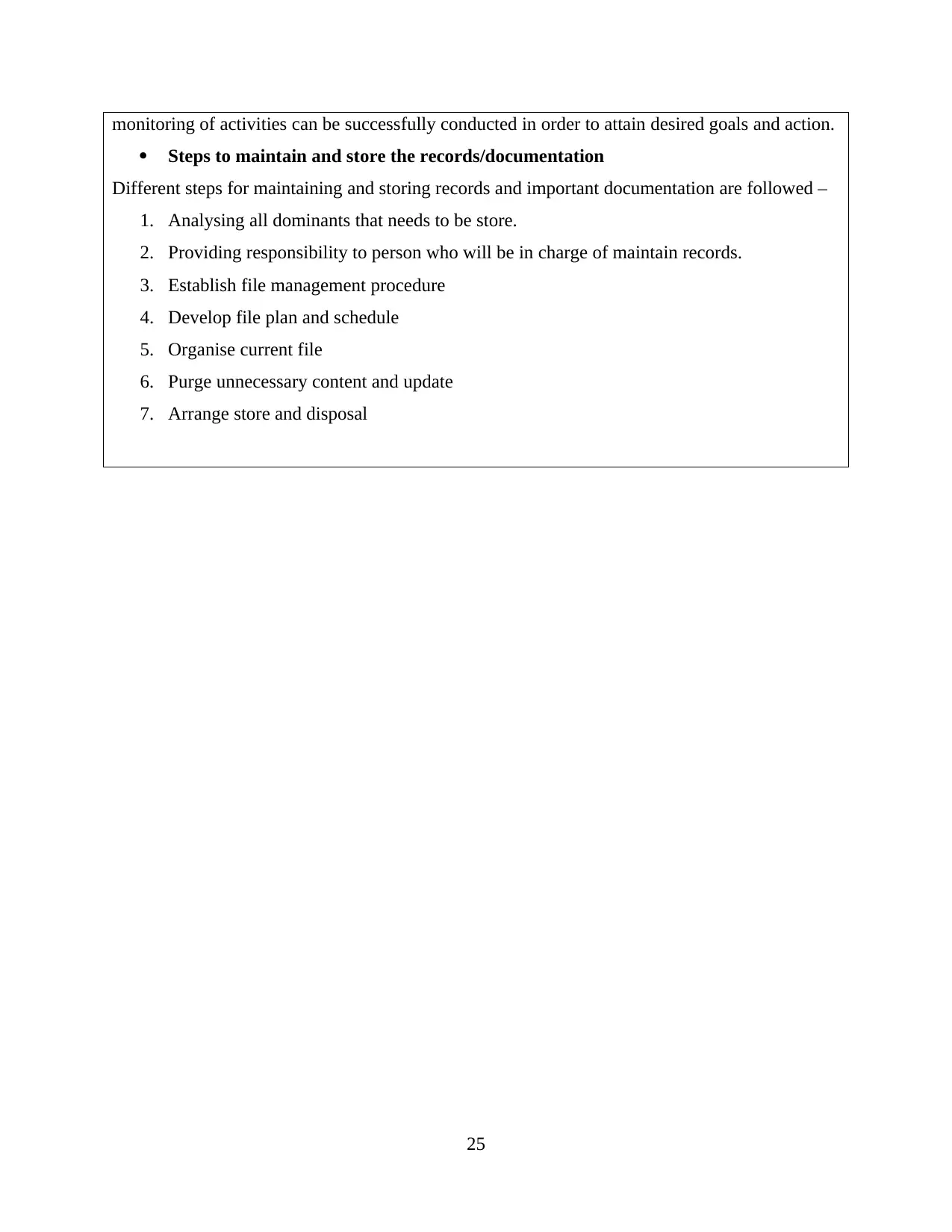
monitoring of activities can be successfully conducted in order to attain desired goals and action.
Steps to maintain and store the records/documentation
Different steps for maintaining and storing records and important documentation are followed –
1. Analysing all dominants that needs to be store.
2. Providing responsibility to person who will be in charge of maintain records.
3. Establish file management procedure
4. Develop file plan and schedule
5. Organise current file
6. Purge unnecessary content and update
7. Arrange store and disposal
25
Steps to maintain and store the records/documentation
Different steps for maintaining and storing records and important documentation are followed –
1. Analysing all dominants that needs to be store.
2. Providing responsibility to person who will be in charge of maintain records.
3. Establish file management procedure
4. Develop file plan and schedule
5. Organise current file
6. Purge unnecessary content and update
7. Arrange store and disposal
25
Secure Best Marks with AI Grader
Need help grading? Try our AI Grader for instant feedback on your assignments.
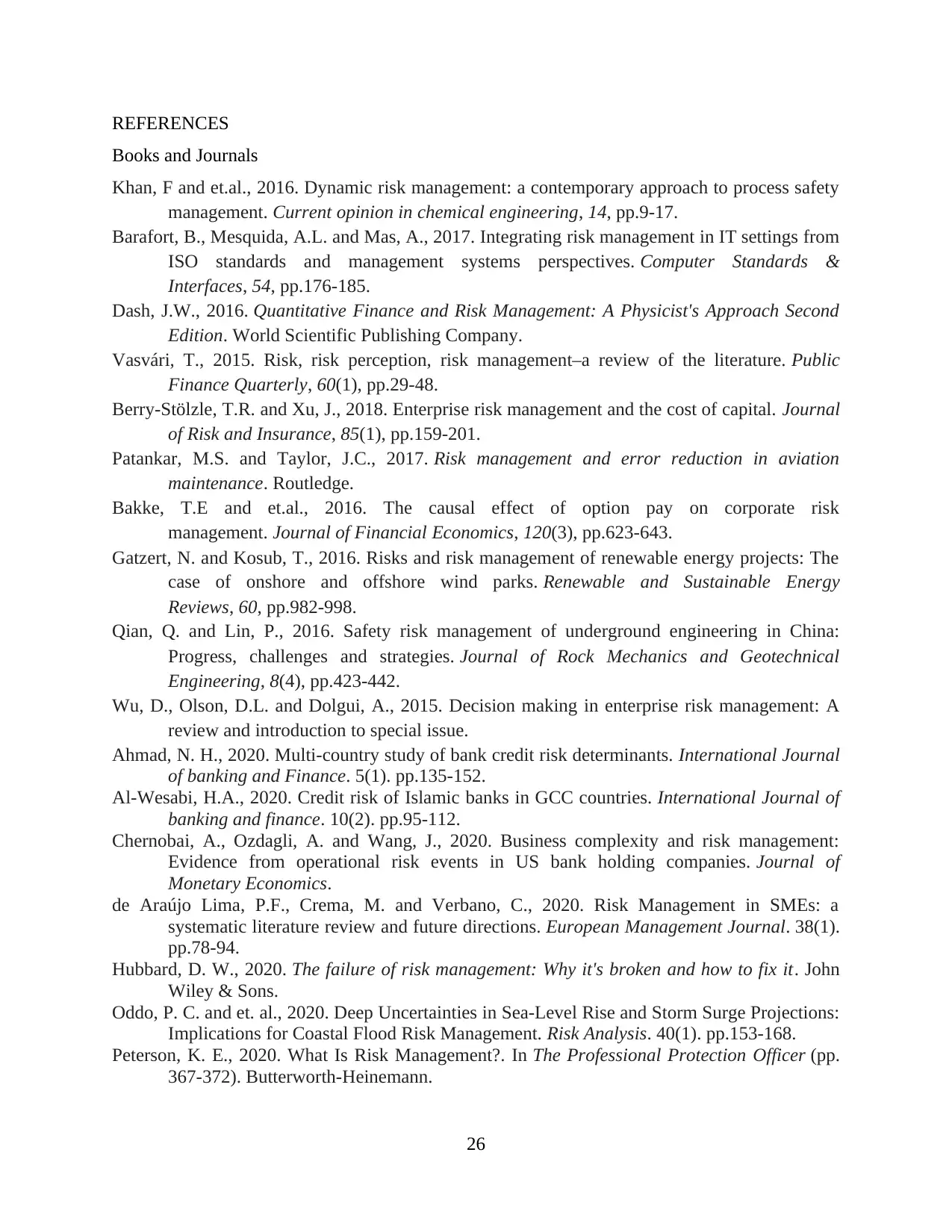
REFERENCES
Books and Journals
Khan, F and et.al., 2016. Dynamic risk management: a contemporary approach to process safety
management. Current opinion in chemical engineering, 14, pp.9-17.
Barafort, B., Mesquida, A.L. and Mas, A., 2017. Integrating risk management in IT settings from
ISO standards and management systems perspectives. Computer Standards &
Interfaces, 54, pp.176-185.
Dash, J.W., 2016. Quantitative Finance and Risk Management: A Physicist's Approach Second
Edition. World Scientific Publishing Company.
Vasvári, T., 2015. Risk, risk perception, risk management–a review of the literature. Public
Finance Quarterly, 60(1), pp.29-48.
Berry‐Stölzle, T.R. and Xu, J., 2018. Enterprise risk management and the cost of capital. Journal
of Risk and Insurance, 85(1), pp.159-201.
Patankar, M.S. and Taylor, J.C., 2017. Risk management and error reduction in aviation
maintenance. Routledge.
Bakke, T.E and et.al., 2016. The causal effect of option pay on corporate risk
management. Journal of Financial Economics, 120(3), pp.623-643.
Gatzert, N. and Kosub, T., 2016. Risks and risk management of renewable energy projects: The
case of onshore and offshore wind parks. Renewable and Sustainable Energy
Reviews, 60, pp.982-998.
Qian, Q. and Lin, P., 2016. Safety risk management of underground engineering in China:
Progress, challenges and strategies. Journal of Rock Mechanics and Geotechnical
Engineering, 8(4), pp.423-442.
Wu, D., Olson, D.L. and Dolgui, A., 2015. Decision making in enterprise risk management: A
review and introduction to special issue.
Ahmad, N. H., 2020. Multi-country study of bank credit risk determinants. International Journal
of banking and Finance. 5(1). pp.135-152.
Al-Wesabi, H.A., 2020. Credit risk of Islamic banks in GCC countries. International Journal of
banking and finance. 10(2). pp.95-112.
Chernobai, A., Ozdagli, A. and Wang, J., 2020. Business complexity and risk management:
Evidence from operational risk events in US bank holding companies. Journal of
Monetary Economics.
de Araújo Lima, P.F., Crema, M. and Verbano, C., 2020. Risk Management in SMEs: a
systematic literature review and future directions. European Management Journal. 38(1).
pp.78-94.
Hubbard, D. W., 2020. The failure of risk management: Why it's broken and how to fix it. John
Wiley & Sons.
Oddo, P. C. and et. al., 2020. Deep Uncertainties in Sea‐Level Rise and Storm Surge Projections:
Implications for Coastal Flood Risk Management. Risk Analysis. 40(1). pp.153-168.
Peterson, K. E., 2020. What Is Risk Management?. In The Professional Protection Officer (pp.
367-372). Butterworth-Heinemann.
26
Books and Journals
Khan, F and et.al., 2016. Dynamic risk management: a contemporary approach to process safety
management. Current opinion in chemical engineering, 14, pp.9-17.
Barafort, B., Mesquida, A.L. and Mas, A., 2017. Integrating risk management in IT settings from
ISO standards and management systems perspectives. Computer Standards &
Interfaces, 54, pp.176-185.
Dash, J.W., 2016. Quantitative Finance and Risk Management: A Physicist's Approach Second
Edition. World Scientific Publishing Company.
Vasvári, T., 2015. Risk, risk perception, risk management–a review of the literature. Public
Finance Quarterly, 60(1), pp.29-48.
Berry‐Stölzle, T.R. and Xu, J., 2018. Enterprise risk management and the cost of capital. Journal
of Risk and Insurance, 85(1), pp.159-201.
Patankar, M.S. and Taylor, J.C., 2017. Risk management and error reduction in aviation
maintenance. Routledge.
Bakke, T.E and et.al., 2016. The causal effect of option pay on corporate risk
management. Journal of Financial Economics, 120(3), pp.623-643.
Gatzert, N. and Kosub, T., 2016. Risks and risk management of renewable energy projects: The
case of onshore and offshore wind parks. Renewable and Sustainable Energy
Reviews, 60, pp.982-998.
Qian, Q. and Lin, P., 2016. Safety risk management of underground engineering in China:
Progress, challenges and strategies. Journal of Rock Mechanics and Geotechnical
Engineering, 8(4), pp.423-442.
Wu, D., Olson, D.L. and Dolgui, A., 2015. Decision making in enterprise risk management: A
review and introduction to special issue.
Ahmad, N. H., 2020. Multi-country study of bank credit risk determinants. International Journal
of banking and Finance. 5(1). pp.135-152.
Al-Wesabi, H.A., 2020. Credit risk of Islamic banks in GCC countries. International Journal of
banking and finance. 10(2). pp.95-112.
Chernobai, A., Ozdagli, A. and Wang, J., 2020. Business complexity and risk management:
Evidence from operational risk events in US bank holding companies. Journal of
Monetary Economics.
de Araújo Lima, P.F., Crema, M. and Verbano, C., 2020. Risk Management in SMEs: a
systematic literature review and future directions. European Management Journal. 38(1).
pp.78-94.
Hubbard, D. W., 2020. The failure of risk management: Why it's broken and how to fix it. John
Wiley & Sons.
Oddo, P. C. and et. al., 2020. Deep Uncertainties in Sea‐Level Rise and Storm Surge Projections:
Implications for Coastal Flood Risk Management. Risk Analysis. 40(1). pp.153-168.
Peterson, K. E., 2020. What Is Risk Management?. In The Professional Protection Officer (pp.
367-372). Butterworth-Heinemann.
26
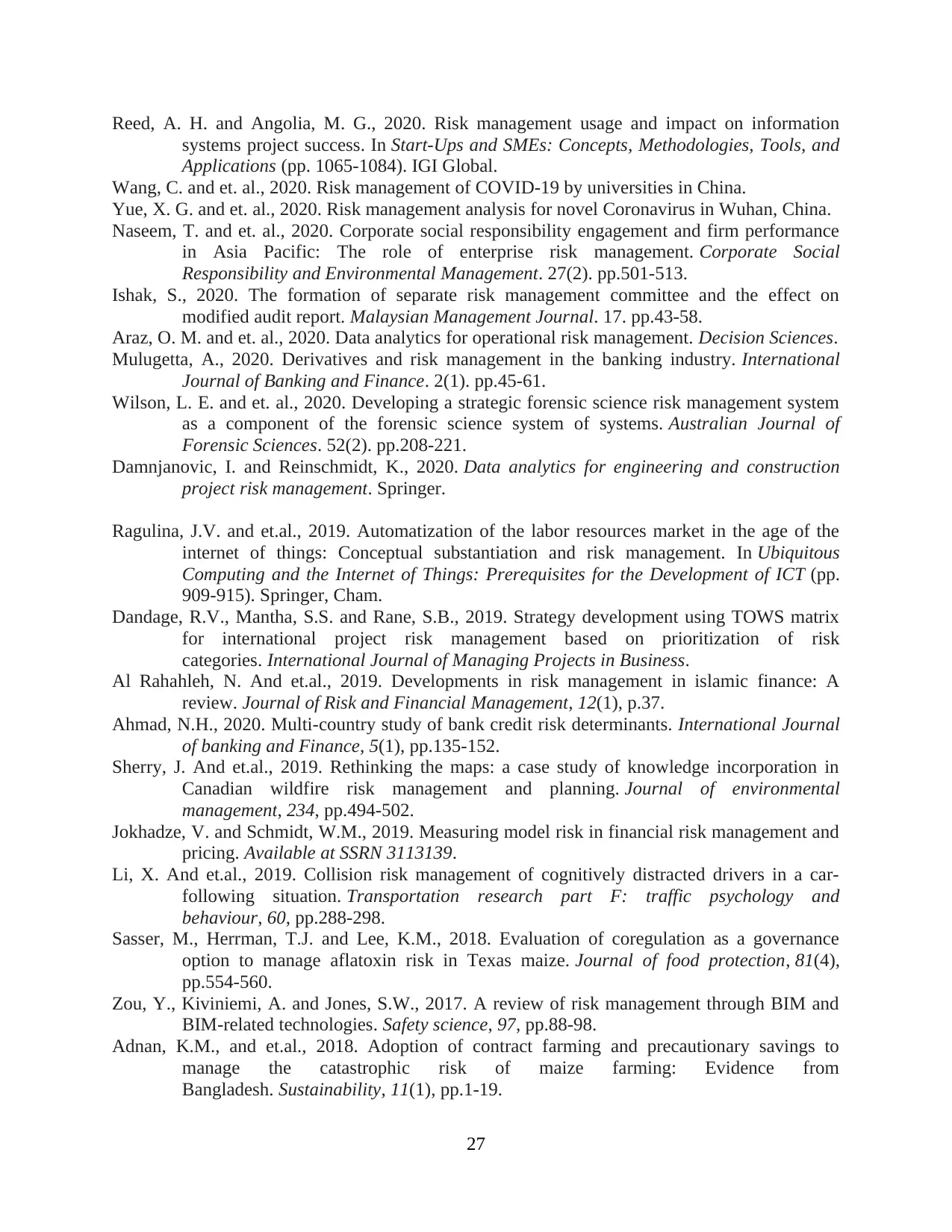
Reed, A. H. and Angolia, M. G., 2020. Risk management usage and impact on information
systems project success. In Start-Ups and SMEs: Concepts, Methodologies, Tools, and
Applications (pp. 1065-1084). IGI Global.
Wang, C. and et. al., 2020. Risk management of COVID-19 by universities in China.
Yue, X. G. and et. al., 2020. Risk management analysis for novel Coronavirus in Wuhan, China.
Naseem, T. and et. al., 2020. Corporate social responsibility engagement and firm performance
in Asia Pacific: The role of enterprise risk management. Corporate Social
Responsibility and Environmental Management. 27(2). pp.501-513.
Ishak, S., 2020. The formation of separate risk management committee and the effect on
modified audit report. Malaysian Management Journal. 17. pp.43-58.
Araz, O. M. and et. al., 2020. Data analytics for operational risk management. Decision Sciences.
Mulugetta, A., 2020. Derivatives and risk management in the banking industry. International
Journal of Banking and Finance. 2(1). pp.45-61.
Wilson, L. E. and et. al., 2020. Developing a strategic forensic science risk management system
as a component of the forensic science system of systems. Australian Journal of
Forensic Sciences. 52(2). pp.208-221.
Damnjanovic, I. and Reinschmidt, K., 2020. Data analytics for engineering and construction
project risk management. Springer.
Ragulina, J.V. and et.al., 2019. Automatization of the labor resources market in the age of the
internet of things: Conceptual substantiation and risk management. In Ubiquitous
Computing and the Internet of Things: Prerequisites for the Development of ICT (pp.
909-915). Springer, Cham.
Dandage, R.V., Mantha, S.S. and Rane, S.B., 2019. Strategy development using TOWS matrix
for international project risk management based on prioritization of risk
categories. International Journal of Managing Projects in Business.
Al Rahahleh, N. And et.al., 2019. Developments in risk management in islamic finance: A
review. Journal of Risk and Financial Management, 12(1), p.37.
Ahmad, N.H., 2020. Multi-country study of bank credit risk determinants. International Journal
of banking and Finance, 5(1), pp.135-152.
Sherry, J. And et.al., 2019. Rethinking the maps: a case study of knowledge incorporation in
Canadian wildfire risk management and planning. Journal of environmental
management, 234, pp.494-502.
Jokhadze, V. and Schmidt, W.M., 2019. Measuring model risk in financial risk management and
pricing. Available at SSRN 3113139.
Li, X. And et.al., 2019. Collision risk management of cognitively distracted drivers in a car-
following situation. Transportation research part F: traffic psychology and
behaviour, 60, pp.288-298.
Sasser, M., Herrman, T.J. and Lee, K.M., 2018. Evaluation of coregulation as a governance
option to manage aflatoxin risk in Texas maize. Journal of food protection, 81(4),
pp.554-560.
Zou, Y., Kiviniemi, A. and Jones, S.W., 2017. A review of risk management through BIM and
BIM-related technologies. Safety science, 97, pp.88-98.
Adnan, K.M., and et.al., 2018. Adoption of contract farming and precautionary savings to
manage the catastrophic risk of maize farming: Evidence from
Bangladesh. Sustainability, 11(1), pp.1-19.
27
systems project success. In Start-Ups and SMEs: Concepts, Methodologies, Tools, and
Applications (pp. 1065-1084). IGI Global.
Wang, C. and et. al., 2020. Risk management of COVID-19 by universities in China.
Yue, X. G. and et. al., 2020. Risk management analysis for novel Coronavirus in Wuhan, China.
Naseem, T. and et. al., 2020. Corporate social responsibility engagement and firm performance
in Asia Pacific: The role of enterprise risk management. Corporate Social
Responsibility and Environmental Management. 27(2). pp.501-513.
Ishak, S., 2020. The formation of separate risk management committee and the effect on
modified audit report. Malaysian Management Journal. 17. pp.43-58.
Araz, O. M. and et. al., 2020. Data analytics for operational risk management. Decision Sciences.
Mulugetta, A., 2020. Derivatives and risk management in the banking industry. International
Journal of Banking and Finance. 2(1). pp.45-61.
Wilson, L. E. and et. al., 2020. Developing a strategic forensic science risk management system
as a component of the forensic science system of systems. Australian Journal of
Forensic Sciences. 52(2). pp.208-221.
Damnjanovic, I. and Reinschmidt, K., 2020. Data analytics for engineering and construction
project risk management. Springer.
Ragulina, J.V. and et.al., 2019. Automatization of the labor resources market in the age of the
internet of things: Conceptual substantiation and risk management. In Ubiquitous
Computing and the Internet of Things: Prerequisites for the Development of ICT (pp.
909-915). Springer, Cham.
Dandage, R.V., Mantha, S.S. and Rane, S.B., 2019. Strategy development using TOWS matrix
for international project risk management based on prioritization of risk
categories. International Journal of Managing Projects in Business.
Al Rahahleh, N. And et.al., 2019. Developments in risk management in islamic finance: A
review. Journal of Risk and Financial Management, 12(1), p.37.
Ahmad, N.H., 2020. Multi-country study of bank credit risk determinants. International Journal
of banking and Finance, 5(1), pp.135-152.
Sherry, J. And et.al., 2019. Rethinking the maps: a case study of knowledge incorporation in
Canadian wildfire risk management and planning. Journal of environmental
management, 234, pp.494-502.
Jokhadze, V. and Schmidt, W.M., 2019. Measuring model risk in financial risk management and
pricing. Available at SSRN 3113139.
Li, X. And et.al., 2019. Collision risk management of cognitively distracted drivers in a car-
following situation. Transportation research part F: traffic psychology and
behaviour, 60, pp.288-298.
Sasser, M., Herrman, T.J. and Lee, K.M., 2018. Evaluation of coregulation as a governance
option to manage aflatoxin risk in Texas maize. Journal of food protection, 81(4),
pp.554-560.
Zou, Y., Kiviniemi, A. and Jones, S.W., 2017. A review of risk management through BIM and
BIM-related technologies. Safety science, 97, pp.88-98.
Adnan, K.M., and et.al., 2018. Adoption of contract farming and precautionary savings to
manage the catastrophic risk of maize farming: Evidence from
Bangladesh. Sustainability, 11(1), pp.1-19.
27
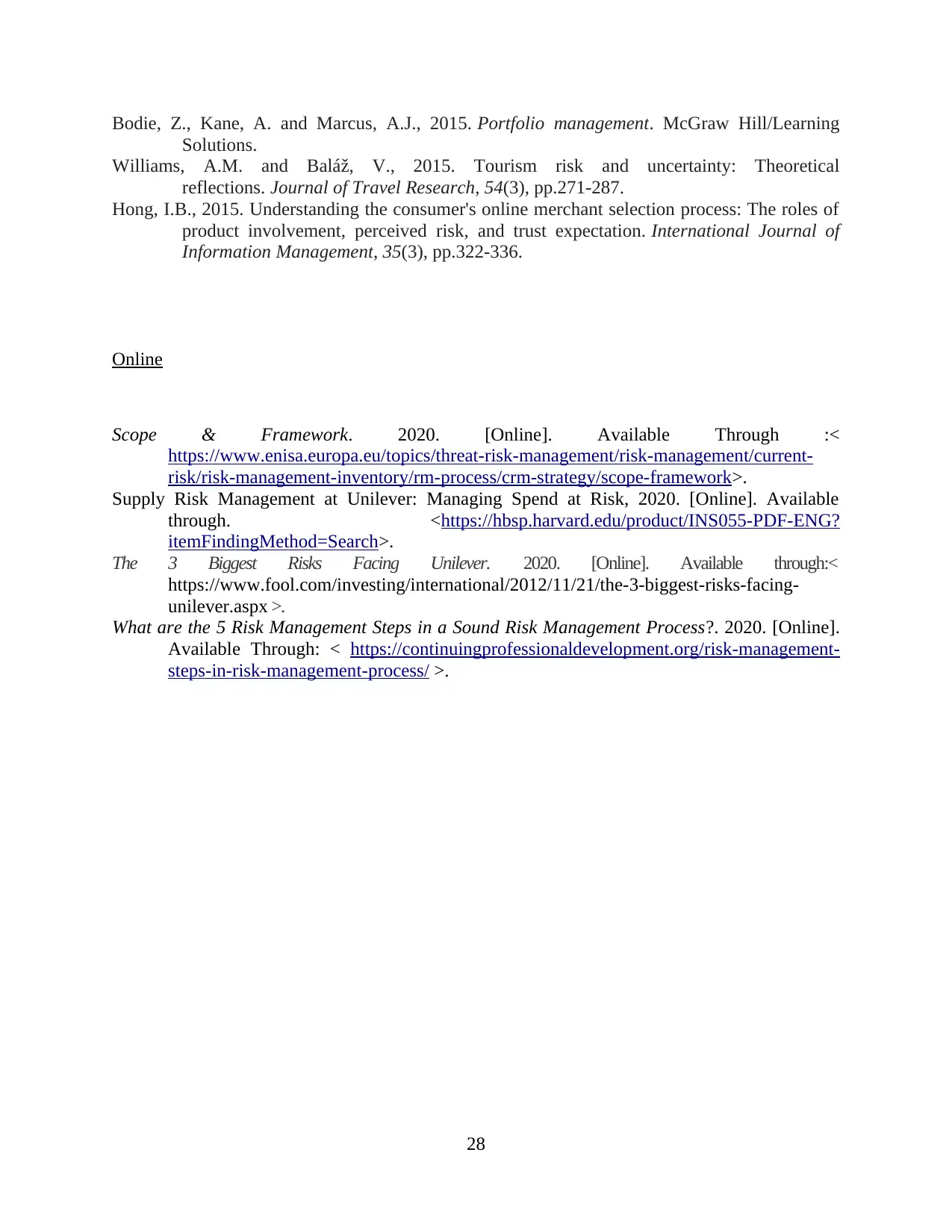
Bodie, Z., Kane, A. and Marcus, A.J., 2015. Portfolio management. McGraw Hill/Learning
Solutions.
Williams, A.M. and Baláž, V., 2015. Tourism risk and uncertainty: Theoretical
reflections. Journal of Travel Research, 54(3), pp.271-287.
Hong, I.B., 2015. Understanding the consumer's online merchant selection process: The roles of
product involvement, perceived risk, and trust expectation. International Journal of
Information Management, 35(3), pp.322-336.
Online
Scope & Framework. 2020. [Online]. Available Through :<
https://www.enisa.europa.eu/topics/threat-risk-management/risk-management/current-
risk/risk-management-inventory/rm-process/crm-strategy/scope-framework>.
Supply Risk Management at Unilever: Managing Spend at Risk, 2020. [Online]. Available
through. <https://hbsp.harvard.edu/product/INS055-PDF-ENG?
itemFindingMethod=Search>.
The 3 Biggest Risks Facing Unilever. 2020. [Online]. Available through:<
https://www.fool.com/investing/international/2012/11/21/the-3-biggest-risks-facing-
unilever.aspx >.
What are the 5 Risk Management Steps in a Sound Risk Management Process?. 2020. [Online].
Available Through: < https://continuingprofessionaldevelopment.org/risk-management-
steps-in-risk-management-process/ >.
28
Solutions.
Williams, A.M. and Baláž, V., 2015. Tourism risk and uncertainty: Theoretical
reflections. Journal of Travel Research, 54(3), pp.271-287.
Hong, I.B., 2015. Understanding the consumer's online merchant selection process: The roles of
product involvement, perceived risk, and trust expectation. International Journal of
Information Management, 35(3), pp.322-336.
Online
Scope & Framework. 2020. [Online]. Available Through :<
https://www.enisa.europa.eu/topics/threat-risk-management/risk-management/current-
risk/risk-management-inventory/rm-process/crm-strategy/scope-framework>.
Supply Risk Management at Unilever: Managing Spend at Risk, 2020. [Online]. Available
through. <https://hbsp.harvard.edu/product/INS055-PDF-ENG?
itemFindingMethod=Search>.
The 3 Biggest Risks Facing Unilever. 2020. [Online]. Available through:<
https://www.fool.com/investing/international/2012/11/21/the-3-biggest-risks-facing-
unilever.aspx >.
What are the 5 Risk Management Steps in a Sound Risk Management Process?. 2020. [Online].
Available Through: < https://continuingprofessionaldevelopment.org/risk-management-
steps-in-risk-management-process/ >.
28
1 out of 31
Related Documents
Your All-in-One AI-Powered Toolkit for Academic Success.
+13062052269
info@desklib.com
Available 24*7 on WhatsApp / Email
![[object Object]](/_next/static/media/star-bottom.7253800d.svg)
Unlock your academic potential
© 2024 | Zucol Services PVT LTD | All rights reserved.





